Metal Matrix Composite in Heat Sink Application: Reinforcement, Processing, and Properties
Abstract
:1. Introduction
2. Metal Matrix Composites
2.1. Copper Matrix Composites
2.1.1. Diamond Reinforcements
2.1.2. Graphite Reinforcements
2.1.3. Carbon Fiber Reinforcements
2.1.4. Carbon Nanotubes (CNTs)
2.1.5. Graphene
2.1.6. Silicon Carbide (SiC)
2.1.7. Metal Particles
2.1.8. Metal Oxides
2.2. Aluminum Matrix Composites (AMCs)
2.2.1. Carbide, Nitride, and Oxide reinforcements
2.2.2. Carbon-Based Reinforcements
2.3. Silver Matrix Composite
2.4. Magnesium Matrix Composite
2.5. Beryllium Matrix Composite
2.6. Indium Matrix Composite
3. MMC Processing
3.1. Liquid State Processing
3.1.1. Stir Casting Process
3.1.2. Liquid Metal Infiltration
Squeeze Casting
Gas/ Vacuum Pressure Infiltration
3.2. Powder Metallurgy
3.2.1. Hot Press Sintering
3.2.2. Pulsed Electric Current Sintering (PECS)
3.2.3. Microwave Sintering
4. Potential Heat Sink Materials
5. Conclusions
- Copper and aluminum are the most commonly used matrix materials for heat sink composites. Diamond particles were observed to be the most promising reinforcement when the interfacial bonding was improved either by alloying matrix or by surface metallization of diamond particles by a carbide-forming element.
- Another important technique to improve interfacial bonding and thereby the thermal properties in Al/diamond composites is to promote the formation of an Al-C diffusion layer. The formation of a diffusion layer precedes the precipitation of a brittle, hydrophilic interfacial phase of Al4C3 that serves as a thermal barrier.
- The MMCs with other lone carbon-based reinforcements like graphite, carbon fiber, CNTs, and graphene are generally reported to demonstrate unacceptable and anisotropic thermal performances.
- A trend setting approach was noticed when a diamond film was coated on another reinforcement in the fabrication of AMCs. A significantly high ratio of thermal conductivity to diamond loading was observed with merely a small volume percentage of diamond. This technique needs to be further explored to establish the feasibility of this technique in providing MMCs with an acceptable thermal performance. This technique may not only reduce diamond loading but also reduce the overall cost.
- Using graphite foam or metallic foam coated with carbon-based reinforcements is another step towards obtaining MMCs with isotropic properties. Further, it can provide an effective heat transfer path for better heat conduction.
- The AMCs with acceptable and/or close to acceptable thermal performances possess a very high specific thermal conductivity, which makes them more attractive for heat sink applications in portable electronic devices.
- Among the liquid state processing techniques, the gas pressure infiltration technique has emerged as being effective. This technique offers control over the infiltration temperature, pressure, and reinforcement-matrix melt contact time. This feature can be exploited to improve the interfacial bonding between the reinforcement and the matrix material.
- The SPS and hot press sintering has emerged to be the most common sintering methods when the powder metallurgy route is adopted for the fabrication of MMCs. Though microwave sintering is hailed to offer significant advantages over other methods, it has rarely been used, and it needs to be further explored.
- In view of the above findings, it can be concluded that the thermal performance of the composites is affected not only by the type of reinforcements, but also by the techniques to improve the interfacial bonding and processing routes. The novel techniques should be further explored to meet the ever-increasing thermal management challenges.
Author Contributions
Funding
Institutional Review Board Statement
Informed Consent Statement
Conflicts of Interest
References
- Khattak, Z.; Ali, H.M. Air cooled heat sink geometries subjected to forced flow: A critical review. Int. J. Heat Mass Transf. 2019, 130, 141–161. [Google Scholar] [CrossRef]
- Chingulpitak, S.; Wongwises, S. A review of the effect of flow directions and behaviors on the thermal performance of conventional heat sinks. Int. J. Heat Mass Transf. 2015, 81, 10–18. [Google Scholar] [CrossRef]
- Ahmed, H.E.; Salman, B.H.; Kherbeet, A.S.; Ahmed, M.I. Optimization of thermal design of heat sinks: A review. Int. J. Heat Mass Transf. 2018, 118, 129–153. [Google Scholar] [CrossRef]
- Pawar, S.P.; Ghuge, N.C.; Palande, D.D. Review—Design and Analysis of Heat Sink Optimization and its Comparison with Commercially Available Heat Sink. Int. J. Appl. Innov. Eng. Manag. 2015, 4, 101–104. [Google Scholar] [CrossRef]
- Martinez-Maradiaga, D.; Damonte, A.; Manzo, A.; Haertel, J.H.; Engelbrecht, K. Design and testing of topology optimized heat sinks for a tablet. Int. J. Heat Mass Transf. 2019, 142, 118429. [Google Scholar] [CrossRef]
- Miranda, A.; Barekar, N.; McKay, B.J. MWCNTs and their use in Al-MMCs for ultra-high thermal conductivity applications: A review. J. Alloy. Compd. 2019, 774, 820–840. [Google Scholar] [CrossRef]
- Zweben, C. Advances in composite materials for thermal management in electronic packaging. JOM 1998, 50, 47–51. [Google Scholar] [CrossRef]
- Tong, H.M. Microelectronics packaging: Present and future. Mater. Chem. Phys. 1995, 40, 147–161. [Google Scholar] [CrossRef]
- Bogatin, E. High Performane Packaging Solutions; Integrated Circuit Engineering Corporation: Scottsdale, AZ, USA, 1991. [Google Scholar]
- Gong, L.; Li, Y.; Bai, Z.; Xu, M. Thermal performance of micro-channel heat sink with metallic porous/solid compound fin design. Appl. Therm. Eng. 2018, 137, 288–295. [Google Scholar] [CrossRef]
- Neubauer, E.; Angerer, P.; Korb, G. Heat sink materials with tailored properties for thermal management. In Proceedings of the 28th International Spring Seminar on Electronics Technology Meeting the Challenges of Electronics Technology Progress, 2005, Wiener Neustadt, Austria, 19–20 May 2005. [Google Scholar] [CrossRef]
- Occhionero, M.A.; Adams, R.W. AlSiC, and AlSiC hybrid composites for flip chips, optoelectronics, power, and high brightness LED thermal management solutions. In Proceedings of the 2005 6th International Conference on Electronic Packaging Technology, Shenzhen, China, 30 August–2 September 2005. [Google Scholar] [CrossRef]
- Razeeb, K.M.; Dalton, E.; Cross, G.L.W.; Robinson, A.J. Present and future thermal interface materials for electronic devices. Int. Mater. Rev. 2018, 63, 1–21. [Google Scholar] [CrossRef]
- Smoyer, J.L.; Norris, P.M. Brief Historical Perspective in Thermal Management and the Shift Toward Management at the Nanoscale. Heat Transf. Eng. 2019, 40, 269–282. [Google Scholar] [CrossRef]
- Shen, Y.L.; Needleman, A.; Suresh, S. Coefficients of thermal expansion of metal-matrix composites for electronic packaging. Metall. Mater. Trans. A 1994, 25, 839–850. [Google Scholar] [CrossRef]
- Pop, E.; Sinha, S.; Goodson, K.E. Heat generation and transport in nanometer-scale transistors. Proc. IEEE 2006, 94, 1587–1601. [Google Scholar] [CrossRef]
- Garimella, S.V.; Fleischer, A.S.; Murthy, J.Y.; Keshavarzi, A.; Prasher, R.; Patel, C.; Bhavnani, S.H.; Venkatasubramanian, R.; Mahajan, R.; Joshi, Y.; et al. Thermal challenges in next-generation electronic systems. IEEE Trans. Compon. Packag. Technol. 2008, 31, 801–815. [Google Scholar] [CrossRef]
- Hansson, J.; Nilsson, T.M.J.; Ye, L.; Liu, J. Novel nanostructured thermal interface materials: A review. Int. Mater. Rev. 2018, 63, 22–45. [Google Scholar] [CrossRef]
- Pedram, M.; Nazarian, S. Thermal modeling, analysis, and management in VLSI circuits: Principles and methods. Proc. IEEE 2006, 94, 1487–1501. [Google Scholar] [CrossRef] [Green Version]
- Reda, S.; Cochran, R.; Nowroz, A.N. Improved thermal tracking for processors using hard and soft sensor allocation techniques. IEEE Trans. Comput. 2011, 60, 841–851. [Google Scholar] [CrossRef]
- Wei, J. Challenges in cooling design of CPU packages for high-performance servers. Heat Transf. Eng. 2008, 29, 178–187. [Google Scholar] [CrossRef]
- Mallik, S.; Ekere, N.; Best, C.; Bhatti, R. Investigation of thermal management materials for automotive electronic control units. Appl. Therm. Eng. 2011, 31, 355–362. [Google Scholar] [CrossRef] [Green Version]
- Abbas, A.; Wang, C.C. Augmentation of natural convection heat sink via using displacement design. Int. J. Heat Mass Transf. 2020, 154, 119757. [Google Scholar] [CrossRef]
- Choi, J.; Jeong, M. Compact, lightweight, and highly efficient circular heat sink design for high-end PCs. Appl. Therm. Eng. 2016, 92, 162–171. [Google Scholar] [CrossRef]
- Chung, D.D.L. Materials for thermal conduction. Appl. Therm. Eng. 2001, 21, 1593–1605. [Google Scholar] [CrossRef]
- Tjong, S.C.; Ma, Z.Y. Microstructural and mechanical characteristics of in situ metal matrix composites. Mater. Sci. Eng. 2000, 29, 49–113. [Google Scholar] [CrossRef]
- Tham, L.M.; Gupta, M.; Cheng, L. Influence of processing parameters on the near-net shape synthesis of aluminium-based metal matrix composites. J. Mater. Process. Technol. 1999, 89–90, 128–134. [Google Scholar] [CrossRef]
- Han, X.H.; Wang, Q.; Park, Y.G.; T’Joen, C.; Sommers, A.; Jacobi, A. A review of metal foam and metal matrix composites for heat exchangers and heat sinks. Heat Transf. Eng. 2012, 33, 991–1009. [Google Scholar] [CrossRef] [Green Version]
- Rawal, S. Metal-matrix composites for space applications. JOM 2001, 53, 14–17. [Google Scholar] [CrossRef]
- Rao, V.; Murthy, M.K.; Nagaraju, J. Thermal conductivity and thermal contact conductance studies on Al2O3/Al–AlN metal matrix composite. Compos. Sci. Technol. 2004, 64, 2459–2462. [Google Scholar] [CrossRef] [Green Version]
- Miracle, D.B. Metal matrix composites—From science to technological significance. Compos. Sci. Technol. 2005, 65, 2526–2540. [Google Scholar] [CrossRef]
- Rosso, M. Ceramic and metal matrix composites: Routes and properties. J. Mater. Process. Technol. 2006, 175, 364–375. [Google Scholar] [CrossRef]
- Schöbel, M.; Altendorfer, W.; Degischer, H.; Vaucher, S.; Buslaps, T.; Di Michiel, M.; Hofmann, M. Internal stresses and voids in SiC particle reinforced aluminum composites for heat sink applications. Compos. Sci. Technol. 2011, 71, 724–733. [Google Scholar] [CrossRef] [Green Version]
- Sidhu, S.S.; Kumar, S.; Batish, A. Metal Matrix Composites for Thermal Management: A Review. Crit. Rev. Solid State Mater. Sci. 2016, 41, 132–157. [Google Scholar] [CrossRef]
- Qu, X.H.; Zhang, L.; Wu, M.; Ren, S. Bin Review of metal matrix composites with high thermal conductivity for thermal management applications. Prog. Nat. Sci. Mater. Int. 2011, 21, 189–197. [Google Scholar] [CrossRef] [Green Version]
- Abyzov, A.M.; Shakhov, F.M.; Averkin, A.I.; Nikolaev, V.I. Mechanical properties of a diamond-copper composite with high thermal conductivity. Mater. Des. 2015, 87, 527–539. [Google Scholar] [CrossRef]
- Fatoba, O.S.; Popoola, O.; Popoola, A.P.I. The Effects of Silicon Carbide Reinforcement on the Properties of Cu/SiCp Composites. Silicon 2015, 7, 351–356. [Google Scholar] [CrossRef]
- He, J.; Wang, X.; Zhang, Y.; Zhao, Y.; Zhang, H. Thermal conductivity of Cu-Zr/diamond composites produced by high temperature-high pressure method. Compos. Part B Eng. 2015, 68, 22–26. [Google Scholar] [CrossRef]
- Silvain, J.F.; Veillère, A.; Lu, Y. Copper-carbon and aluminum-carbon composites fabricated by powder metallurgy processes. J. Phys. Conf. Ser. 2014, 525. [Google Scholar] [CrossRef] [Green Version]
- Kang, Q.; He, X.; Ren, S.; Liu, T.; Liu, Q.; Wu, M.; Qu, X. Microstructure and thermal properties of copper-diamond composites with tungsten carbide coating on diamond particles. Mater. Charact. 2015, 105, 18–23. [Google Scholar] [CrossRef]
- Kang, Q.; He, X.; Ren, S.; Zhang, L.; Wu, M.; Guo, C.; Cui, W.; Qu, X. Preparation of copper-diamond composites with chromium carbide coatings on diamond particles for heat sink applications. Appl. Therm. Eng. 2013, 60, 423–429. [Google Scholar] [CrossRef]
- Tejado, E.; Müller, A.V.; You, J.H.; Pastor, J.Y. The thermo-mechanical behaviour of W-Cu metal matrix composites for fusion heat sink applications: The influence of the Cu content. J. Nucl. Mater. 2018, 498, 468–475. [Google Scholar] [CrossRef] [Green Version]
- Tejado, E.; Müller, A.V.; You, J.H.; Pastor, J.Y. Evolution of mechanical performance with temperature of W/Cu and W/CuCrZr composites for fusion heat sink applications. Mater. Sci. Eng. A 2018, 712, 738–746. [Google Scholar] [CrossRef] [Green Version]
- Schubert, T.; Weidmüller, H.; Weißgärber, T.; Kieback, B. Carbide formation in copper-carbon composites and its effect on thermal conductivity. In Advances in Powder Metallurgy & Particulate Materials, Proceedings of the 2007 International Conference on Powder Metallurgy & Particulate Materials, PowderMet; Metal Powder Industries Federation: Denver, CO, USA, 2007; pp. 910–918. [Google Scholar]
- Xia, Y.; Song, Y.-Q.; Lin, C.-G.; Cui, S.; Fang, Z.-Z. Effect of carbide formers on microstructure and thermal conductivity of diamond-Cu composites for heat sink materials. Trans. Nonferrous Met. Soc. China 2009, 19, 1161–1166. [Google Scholar] [CrossRef]
- Wang, L.; Li, J.; Bai, G.; Li, N.; Wang, X.; Zhang, H.; Wang, J.; Kim, M.J. Interfacial structure evolution and thermal conductivity of Cu-Zr/diamond composites prepared by gas pressure infiltration. J. Alloy. Compd. 2019, 781, 800–809. [Google Scholar] [CrossRef]
- Xie, Z.; Guo, H.; Zhang, Z.; Zhang, X. Thermal expansion behaviour and dimensional stability of Diamond/Cu composites with different diamond content. J. Alloy. Compd. 2019, 797, 122–130. [Google Scholar] [CrossRef]
- Pan, Y.; He, X.; Ren, S.; Wu, M.; Qu, X. Optimized thermal conductivity of diamond/Cu composite prepared with tungsten-copper-coated diamond particles by vacuum sintering technique. Vacuum 2018, 153, 74–81. [Google Scholar] [CrossRef]
- Chang, G.; Sun, F.; Wang, L.; Che, Z.; Wang, X.; Wang, J.; Kim, M.J.; Zhang, H. Regulated Interfacial Thermal Conductance between Cu and Diamond by a TiC Interlayer for Thermal Management Applications. ACS Appl. Mater. Interfaces 2019, 11, 26507–26517. [Google Scholar] [CrossRef]
- Ciupiński, Ł.; Kruszewski, M.J.; Grzonka, J.; Chmielewski, M.; Zielińsk, R.; Moszczyńska, D.; Michalski, A. Design of interfacial Cr3C2 carbide layer via optimization of sintering parameters used to fabricate copper/diamond composites for thermal management applications. Mater. Des. 2017, 120, 170–185. [Google Scholar] [CrossRef]
- Wu, Y.; Luo, J.; Wang, Y.; Wang, G.; Wang, H.; Yang, Z.; Ding, G. Critical effect and enhanced thermal conductivity of Cu-diamond composites reinforced with various diamond prepared by composite electroplating. Ceram. Int. 2019, 45, 13225–13234. [Google Scholar] [CrossRef]
- Grech, D.F.; Abela, S.; Attard, M.; Sinagra, E. Coating of diamond particles for production of metal matrix composites. Surf. Eng. 2013, 29, 244–246. [Google Scholar] [CrossRef]
- Kang, Q.; He, X.; Ren, S.; Zhang, L.; Wu, M.; Guo, C.; Liu, Q.; Liu, T.; Qu, X. Effect of molybdenum carbide intermediate layers on thermal properties of copper-diamond composites. J. Alloy. Compd. 2013, 576, 380–385. [Google Scholar] [CrossRef]
- Che, Q.L.; Chen, X.K.; Ji, Y.Q.; Li, Y.W.; Wang, L.X.; Cao, S.Z.; Jiang, Y.G.; Wang, Z. The influence of minor titanium addition on thermal properties of diamond/copper composites via in situ reactive sintering. Mater. Sci. Semicond. Process. 2015, 30, 104–111. [Google Scholar] [CrossRef]
- Cho, H.J.; Yan, D.; Tam, J.; Erb, U. Effects of diamond particle size on the formation of copper matrix and the thermal transport properties in electrodeposited copper-diamond composite materials. J. Alloy. Compd. 2019, 791, 1128–1137. [Google Scholar] [CrossRef]
- Rosinski, M.; Ciupinski, L.; Grzonka, J.; Michalski, A.; Kurzydlowski, K.J. Synthesis and characterization of the diamond/copper composites produced by the pulse plasma sintering (PPS) method. Diam. Relat. Mater. 2012, 27–28, 29–35. [Google Scholar] [CrossRef]
- Nunes, D.; Correia, J.B.; Carvalho, P.A.; Shohoji, N.; Fernandes, H.; Silva, C.; Alves, L.C.; Hanada, K.; Ösawa, E. Production of Cu/diamond composites for first-wall heat sinks. Fusion Eng. Des. 2011, 86, 2589–2592. [Google Scholar] [CrossRef]
- Abyzov, A.M.; Kruszewski, M.J.; Ciupiński, Ł.; Mazurkiewicz, M.; Michalski, A.; Kurzydłowski, K.J. Diamond-tungsten based coating-copper composites with high thermal conductivity produced by Pulse Plasma Sintering. Mater. Des. 2015, 76, 97–109. [Google Scholar] [CrossRef]
- Abyzov, A.M.; Kidalov, S.V.; Shakhov, F.M. High thermal conductivity composite of diamond particles with tungsten coating in a copper matrix for heat sink application. Appl. Therm. Eng. 2012, 48, 72–80. [Google Scholar] [CrossRef]
- Wang, L.; Li, J.; Catalano, M.; Bai, G.; Li, N.; Dai, J.; Wang, X.; Zhang, H.; Wang, J.; Kim, M.J. Enhanced thermal conductivity in Cu/diamond composites by tailoring the thickness of interfacial TiC layer. Compos. Part A Appl. Sci. Manuf. 2018, 113, 76–82. [Google Scholar] [CrossRef]
- Che, Q.L.; Zhang, J.J.; Chen, X.K.; Ji, Y.Q.; Li, Y.W.; Wang, L.X.; Cao, S.Z.; Guo, L.; Wang, Z.; Wang, S.W.; et al. Spark plasma sintering of titanium-coated diamond and copper-titanium powder to enhance thermal conductivity of diamond/copper composites. Mater. Sci. Semicond. Process. 2015, 33, 67–75. [Google Scholar] [CrossRef]
- Bai, H.; Maa, N.; Lang, J.; Zhu, C. Effect of a new pretreatment on the microstructure and thermal conductivity of Cu/diamond composites. J. Alloy. Compd. 2013, 580, 382–385. [Google Scholar] [CrossRef]
- Liu, R.; Luo, G.; Li, Y.; Zhang, J.; Shen, Q.; Zhang, L. Microstructure and thermal properties of diamond/copper composites with Mo 2 C in-situ nano-coating. Surf. Coat. Technol. 2019, 360, 376–381. [Google Scholar] [CrossRef]
- Zhang, C.; Wang, R.; Cai, Z.; Peng, C.; Feng, Y.; Zhang, L. Effects of dual-layer coatings on microstructure and thermal conductivity of diamond/Cu composites prepared by vacuum hot pressing. Surf. Coat. Technol. 2015, 277, 299–307. [Google Scholar] [CrossRef]
- Li, J.; Wang, X.; Qiao, Y.; Zhang, Y.; He, Z.; Zhang, H. High thermal conductivity through interfacial layer optimization in diamond particles dispersed Zr-alloyed Cu matrix composites. Scr. Mater. 2015, 109, 72–75. [Google Scholar] [CrossRef]
- Zhang, X.; Guo, H.; Yin, F.; Fan, Y.; Zhang, Y. Interfacial microstructure and properties of diamond/Cu-xCr composites for electronic packaging applications. Rare Met. 2011, 30, 94–98. [Google Scholar] [CrossRef]
- Zhang, Y.; Zhang, H.L.; Wu, J.H.; Wang, X.T. Enhanced thermal conductivity in copper matrix composites reinforced with titanium-coated diamond particles. Scr. Mater. 2011, 65, 1097–1100. [Google Scholar] [CrossRef]
- Lambert, M.A.; Fletcher, L.S. Thermal conductivity of graphite/aluminum and graphite/copper composites. J. Heat Transfer 1996, 118, 478–510. [Google Scholar] [CrossRef]
- Yang, W.; Zhou, L.; Peng, K.; Zhu, J.; Wan, L. Effect of tungsten addition on thermal conductivity of graphite/copper composites. Compos. Part B Eng. 2013, 55, 1–4. [Google Scholar] [CrossRef]
- Zhang, H.; Chao, M.; Zhang, H.; Tang, A.; Ren, B.; He, X. Microstructure and thermal properties of copper matrix composites reinforced by chromium-coated discontinuous graphite fibers. Appl. Therm. Eng. 2014, 73, 739–744. [Google Scholar] [CrossRef]
- You, J.H. Copper matrix composites as heat sink materials for water-cooled divertor target. Nucl. Mater. Energy 2015, 5, 7–18. [Google Scholar] [CrossRef] [Green Version]
- Koráb, J.; Štefánik, P.; Kavecký, Š.; Šebo, P.; Korb, G. Thermal conductivity of unidirectional copper matrix carbon fibre composites. Compos. Part A Appl. Sci. Manuf. 2002, 33, 577–581. [Google Scholar] [CrossRef]
- Prakasam, M.; Morvan, A.; Azina, C.; Constantin, L.; Goglio, G.; Largeteau, A.; Bordère, S.; Heintz, J.M.; Lu, Y.; Silvain, J.F. Ultra-low temperature fabrication of copper carbon fibre composites by hydrothermal sintering for heat sinks with enhanced thermal efficiency. Compos. Part A Appl. Sci. Manuf. 2020, 133. [Google Scholar] [CrossRef]
- Chu, K.; Wu, Q.; Jia, C.; Liang, X.; Nie, J.; Tian, W.; Gai, G.; Guo, H. Fabrication and effective thermal conductivity of multi-walled carbon nanotubes reinforced Cu matrix composites for heat sink applications. Compos. Sci. Technol. 2010, 70, 298–304. [Google Scholar] [CrossRef]
- Subramaniam, C.; Yasuda, Y.; Takeya, S.; Ata, S.; Nishizawa, A.; Futaba, D.; Yamada, T.; Hata, K. Carbon nanotube-copper exhibiting metal-like thermal conductivity and silicon-like thermal expansion for efficient cooling of electronics. Nanoscale 2014, 6, 2669–2674. [Google Scholar] [CrossRef]
- Köck, T.; Brendel, A.; Bolt, H. Interface reactions between silicon carbide and interlayers in silicon carbide-copper metal-matrix composites. J. Nucl. Mater. 2007, 362, 197–201. [Google Scholar] [CrossRef]
- Schubert, T.; Brendel, A.; Schmid, K.; Koeck, T.; Ciupiński, Ł.; Zieliński, W.; Weißgärber, T.; Kieback, B. Interfacial design of Cu/SiC composites prepared by powder metallurgy for heat sink applications. Compos. Part A Appl. Sci. Manuf. 2007, 38, 2398–2403. [Google Scholar] [CrossRef] [Green Version]
- Muller, A.V.; Ewert, D.; Galatanu, A.; Milwich, M.; Neu, R.; Pastor, J.Y.; Siefken, U.; Tejado, E.; You, J.H. Melt infiltrated tungsten–copper composites as advanced heat sink materials for plasma facing components of future nuclear fusion devices. Fusion Eng. Des. 2017, 124, 455–459. [Google Scholar] [CrossRef]
- Sampath, A.; Ravi, B.G.; Nguyen, H.; Sudarshan, T.S. Enhancing thermal properties of W/Cu composites. Powder Metall. 2001, 44, 313–316. [Google Scholar] [CrossRef]
- Chen, G.; Wu, G.; Zhu, D.; Zhang, Q. The Thermo-Physical Properties of High Dense Mo/Cu Composites Fabricated by Squeeze Casting Technology. In Proceedings of the 2005 6th International Conference on Electronic Packaging Technology, Schenzen, China, 30 August–2 September 2005; pp. 321–324. [Google Scholar] [CrossRef]
- Das, S.; Das, S.; Das, K. Synthesis and thermal behavior of Cu/Y2W3O 12 composite. Ceram. Int. 2014, 40, 6465–6472. [Google Scholar] [CrossRef]
- Sinha, V.; Spowart, J.E. Influence of interfacial carbide layer characteristics on thermal properties of copper-diamond composites. J. Mater. Sci. 2013, 48, 1330–1341. [Google Scholar] [CrossRef]
- Clyne, T.W.; Withers, P.J. An Introduction to Metal Matrix Composites; Cambridge University Press: Cambridge, UK, 1993. [Google Scholar]
- Weber, L.; Tavangar, R. On the influence of active element content on the thermal conductivity and thermal expansion of Cu-X (X = Cr, B) diamond composites. Scr. Mater. 2007, 57, 988–991. [Google Scholar] [CrossRef]
- Chu, K.; Jia, C.; Guo, H.; Li, W. Microstructure and thermal conductivity of Cu-B/diamond composites. J. Compos. Mater. 2013, 47, 2945–2953. [Google Scholar] [CrossRef]
- Kidalov, S.V.; Shakhov, F.M. Thermal conductivity of diamond composites. Materials 2009, 2, 2467–2495. [Google Scholar] [CrossRef] [Green Version]
- Scott, P.M.; Nicholas, M.; Dewar, B. The wetting and bonding of diamonds by copper-base binary alloys. J. Mater. Sci. 1975, 10, 1833–1840. [Google Scholar] [CrossRef]
- Zhu, C.; Zhu, X.; Zhao, H.; Fa, W.; Yang, X.; Zheng, Z. Thermal physical properties of Al-coated diamond/Cu composites. J. Wuhan Univ. Technol. Sci. Ed. 2015, 30, 315–319. [Google Scholar] [CrossRef]
- Hu, H.; Kong, J. Improved thermal performance of diamond-copper composites with boron carbide coating. J. Mater. Eng. Perform. 2014, 23, 651–657. [Google Scholar] [CrossRef]
- Cui, W.; Xu, H.; Chen, J.-H.; Ren, S.-B.; He, X.-B.; Qu, X.-H. Effect of sintering on the relative density of Cr-coated diamond/Cu composites prepared by spark plasma sintering. Int. J. Miner. Met. Mater. 2016, 23, 716–722. [Google Scholar] [CrossRef]
- Wang, L.; Li, J.; Che, Z.; Wang, X.; Zhang, H.; Wang, J.; Kim, M.J. Combining Cr pre-coating and Cr alloying to improve the thermal conductivity of diamond particles reinforced Cu matrix composites. J. Alloy. Compd. 2018, 749, 1098–1105. [Google Scholar] [CrossRef]
- Zhu, C.; Wang, C.; Lang, J.; Ma, Y.; Ma, N. Si-coated diamond particles reinforced copper composites fabricated by spark plasma sintering process. Mater. Manuf. Process. 2013, 28, 143–147. [Google Scholar] [CrossRef]
- Cho, H.J.; Kim, Y.J.; Erb, U. Thermal conductivity of copper-diamond composite materials produced by electrodeposition and the effect of TiC coatings on diamond particles. Compos. Part B Eng. 2018, 155, 197–203. [Google Scholar] [CrossRef]
- Vrable, D.L.; Gottschlich, J.M. Graphite foam/copper composite substrate for electronic cooling. In Proceedings of the Collection of Technical Papers—4th International Energy Conversion Engineering Conference, San Diego, CA, USA, 18 June 2006; pp. 593–602. [Google Scholar]
- Korab, J.; Korb, G.; Sebo, P. Thermal expansion and thermal conductivity of continuous carbon fibre reinforced copper matrix composites. Proc. IEEE/CPMT Int. Electron. Manuf. Technol. Symp. 1998, 104–108. [Google Scholar] [CrossRef]
- Chu, K.; Wang, X.-H.; Wang, F.; Li, Y.-B.; Huang, D.-J.; Liu, H.; Ma, W.-L.; Liu, F.-X.; Zhang, H. Largely enhanced thermal conductivity of graphene/copper composites with highly aligned graphene network. Carbon 2018, 127, 102–112. [Google Scholar] [CrossRef] [Green Version]
- Chu, K.; Wang, X.-H.; Li, Y.-B.; Huang, D.-J.; Geng, Z.-R.; Zhao, X.-L.; Liu, H.; Zhang, H. Thermal properties of graphene/metal composites with aligned graphene. Mater. Des. 2018, 140, 85–94. [Google Scholar] [CrossRef]
- Gao, X.; Yue, H.; Guo, E.; Zhang, H.; Lin, X.; Yao, L.; Wang, B. Mechanical properties and thermal conductivity of graphene reinforced copper matrix composites. Powder Technol. 2016, 301, 601–607. [Google Scholar] [CrossRef]
- El-Kady, O.; Yehia, H.M.; Nouh, F. Preparation and characterization of Cu/(WC-TiC-Co)/graphene nano-composites as a suitable material for heat sink by powder metallurgy method. Int. J. Refract. Met. Hard Mater. 2019, 79, 108–114. [Google Scholar] [CrossRef]
- You, J.H.; Brindel, A.; Nawka, S.; Schubert, T.; Kieback, B. Thermal and mechanical properties of infiltrated W/CuCrZr composite materials for functionally graded heat sink application. J. Nucl. Mater. 2013, 438, 1–6. [Google Scholar] [CrossRef]
- Reddy, M.P.; Shakoor, R.A.; Parande, G.; Manakari, V.; Ubaid, F.; Mohamed, A.M.A.; Gupta, M. Enhanced performance of nano-sized SiC reinforced Al metal matrix nanocomposites synthesized through microwave sintering and hot extrusion techniques. Prog. Nat. Sci. Mater. Int. 2017, 27, 606–614. [Google Scholar] [CrossRef]
- Ruch, P.W.; Beffort, O.; Kleiner, S.; Weber, L.; Uggowitzer, P.J. Selective interfacial bonding in Al(Si)-diamond composites and its effect on thermal conductivity. Compos. Sci. Technol. 2006, 66, 2677–2685. [Google Scholar] [CrossRef]
- Shu, S.; Yang, H.; Tong, C.; Qiu, F. Fabrication of TiCx-TiB2/Al composites for application as a heat sink. Materials 2016, 9, 642. [Google Scholar] [CrossRef] [PubMed] [Green Version]
- Smith, L.J.B.; Corbin, S.F.; Hexemer, R.L.; Donaldson, I.W.; Bishop, D.P. Development and processing of novel aluminum powder metallurgy materials for heat sink applications. Metall. Mater. Trans. A Phys. Metall. Mater. Sci. 2014, 45, 980–989. [Google Scholar] [CrossRef]
- Tayebi, M.; Jozdani, M.; Mirhadi, M. Thermal expansion behavior of Al–B4C composites by powder metallurgy. J. Alloy. Compd. 2019, 809, 151753. [Google Scholar] [CrossRef]
- Wang, P.; Xiu, Z.; Jiang, L.; Chen, G.; Lin, X.; Wu, G. Enhanced thermal conductivity and flexural properties in squeeze casted diamond/aluminum composites by processing control. Mater. Des. 2015, 88, 1347–1352. [Google Scholar] [CrossRef]
- Manivannan, A.; Sasikumar, R.; Joshuva, R.; Singh, D. Thermal Investigation of Aa 6061 Based Particulate. Int. J. Mech. Prod. Eng. 2017, 5, 2320–2322. [Google Scholar]
- Abedinzadeh, R.; Safavi, S.M.; Karimzadeh, F. A study of pressureless microwave sintering, microwave-assisted hot press sintering and conventional hot pressing on properties of aluminium/alumina nanocomposite. J. Mech. Sci. Technol. 2016, 30, 1967–1972. [Google Scholar] [CrossRef]
- Elomari, S.; Boukhili, R.; San Marchi, C.; Mortensen, A.; Lloyd, D.J. Thermal expansion responses of pressure infiltrated SiC/Al metal-matrix composites. J. Mater. Sci. 1997, 32, 2131–2140. [Google Scholar] [CrossRef]
- Sidhu, S.S.; Singh, M.; Singh Bains, P. On the thermal conductivity of bimodal SiC/A356 composites fabricated via powder metallurgy route. Part. Sci. Technol. 2018, 36, 324–331. [Google Scholar] [CrossRef]
- Saraswati, R.; Polese, F.J. Aluminum matrix composite heat sinks for microchips and microcircuits. In Proceedings of the Proceedings of SPIE—The International Society for Optical Engineering, San Diego, CA, USA, 1–4 November 1998; pp. 681–686. [Google Scholar]
- Zhang, Q.; Wu, G.; Jiang, L.; Chen, G. Thermal expansion and dimensional stability of Al-Si matrix composite reinforced with high content SiC. Mater. Chem. Phys. 2003, 82, 780–785. [Google Scholar] [CrossRef]
- Manivannan, A.; Sasikumar, R. Fabrication and Characterization of Aluminium Boron Nitride Composite for Fins. Mater. Today Proc. 2018, 5, 8618–8624. [Google Scholar] [CrossRef]
- Matli, P.R.; Ubaid, F.; Shakoor, R.A.; Parande, G.; Manakari, V.; Yusuf, M.; Amer Mohamed, A.M.; Gupta, M. Improved properties of Al-Si3N4 nanocomposites fabricated through a microwave sintering and hot extrusion process. RSC Adv. 2017, 7, 34401–34410. [Google Scholar] [CrossRef] [Green Version]
- Zhang, Q.; Chen, G.; Wu, G.; Xiu, Z.; Luan, B. Property characteristics of a AlNp/Al composite fabricated by squeeze casting technology. Mater. Lett. 2003, 57, 1453–1458. [Google Scholar] [CrossRef]
- Feng, H.; Yu, J.K.; Tan, W. Microstructure and thermal properties of diamond/aluminum composites with TiC coating on diamond particles. Mater. Chem. Phys. 2010, 124, 851–855. [Google Scholar] [CrossRef]
- Ma, L.; Zhang, L.; Zhao, P.; Hu, N.; Gong, Z.; Ye, W.; Wei, Q.; Zhou, K.; Yu, Z.; Zhang, Y. A new design of composites for thermal management: Aluminium reinforced with continuous CVD diamond coated W spiral wires. Mater. Des. 2016, 101, 109–116. [Google Scholar] [CrossRef]
- Schöbel, M.; Degischer, H.P.; Vaucher, S.; Hofmann, M.; Cloetens, P. Reinforcement architectures and thermal fatigue in diamond particle-reinforced aluminum. Acta Mater. 2010, 58, 6421–6430. [Google Scholar] [CrossRef]
- Beffort, O.; Khalid, F.A.; Weber, L.; Ruch, P.; Klotz, U.E.; Meier, S.; Kleiner, S. Interface formation in infiltrated Al(Si)/diamond composites. Diam. Relat. Mater. 2006, 15, 1250–1260. [Google Scholar] [CrossRef]
- Khalid, F.A.; Beffort, O.; Klotz, U.E.; Keller, B.A.; Gasser, P. Microstructure and interfacial characteristics of aluminium-diamond composite materials. Diam. Relat. Mater. 2004, 13, 393–400. [Google Scholar] [CrossRef]
- Johnson, W.B.; Sonuparlak, B. Diamond/Al metal matrix composites formed by the pressureless metal infiltration process. J. Mater. Res. 1993, 8, 1169–1173. [Google Scholar] [CrossRef]
- Liang, X.; Jia, C.; Chu, K.; Chen, H. Predicted interfacial thermal conductance and thermal conductivity of diamond/Al composites with various interfacial coatings. Rare Met. 2011, 30, 544–549. [Google Scholar] [CrossRef]
- Yang, B.; Yu, J.-K.; Chen, C. Microstructure and thermal expansion of Ti coated diamond/Al composites. Trans. Nonferrous Met. Soc. China 2009, 19, 1167–1173. [Google Scholar] [CrossRef]
- Che, Z.; Li, J.; Wang, Q.; Wang, L.; Zhang, H.; Zhang, Y.; Wang, X.; Wang, J.; Kim, M.J. The formation of atomic-level interfacial layer and its effect on thermal conductivity of W-coated diamond particles reinforced Al matrix composites. Compos. Part A Appl. Sci. Manuf. 2018, 107, 164–170. [Google Scholar] [CrossRef]
- Monje, I.E.; Louis, E.; Molina, J.M. Optimizing thermal conductivity in gas-pressure infiltrated aluminum/diamond composites by precise processing control. Compos. Part A Appl. Sci. Manuf. 2013, 48, 9–14. [Google Scholar] [CrossRef]
- Zhang, Y.; Li, J.; Zhao, L.; Wang, X. Optimisation of high thermal conductivity Al/diamond composites produced by gas pressure infiltration by controlling infiltration temperature and pressure. J. Mater. Sci. 2014, 50, 688–696. [Google Scholar] [CrossRef]
- Chen, J.K.; Huang, I.S. Thermal properties of aluminum-graphite composites by powder metallurgy. Compos. Part B Eng. 2013, 44, 698–703. [Google Scholar] [CrossRef]
- Liu, X.; Wang, W.; Wang, D.; Xiao, B.; Ni, D.; Chen, L.; Ma, Z. Effect of Graphite Flake Size on the Strength and Thermal Conductivity of Graphite Flakes/Al Composites. Jinshu Xuebao Acta Metall. Sin. 2017, 53, 869–878. [Google Scholar] [CrossRef]
- Oddone, V.; Boerner, B.; Reich, S. Composites of aluminum alloy and magnesium alloy with graphite showing low thermal expansion and high specific thermal conductivity. Sci. Technol. Adv. Mater. 2017, 18, 180–186. [Google Scholar] [CrossRef] [Green Version]
- Fukuchi, K.; Sasaki, K.; Katagiri, K.; Imanishi, T.; Kakitsuji, A. Aluminium based high thermal conductive composites containing CNT and VGCF-deformation dependence of thermal conductivity. Procedia Eng. 2011, 10, 912–917. [Google Scholar] [CrossRef]
- Kurita, H.; Feuillet, E.; Guillemet, T.; Heintz, J.M.; Kawasaki, A.; Silvain, J.F. Simple fabrication and characterization of discontinuous carbon fiber reinforced aluminum matrix composite for lightweight heat sink applications. Acta Metall. Sin. 2014, 27, 714–722. [Google Scholar] [CrossRef]
- Pei, R.; Chen, G.; Wang, Y.; Zhao, M.; Wu, G. Effect of interfacial microstructure on the thermal-mechanical properties of mesophase pitch-based carbon fiber reinforced aluminum composites. J. Alloy. Compd. 2018, 756, 8–18. [Google Scholar] [CrossRef]
- Tokunaga, T.; Takahashi, K.; Ohno, M.; Sasaki, K.; Imanishi, T.; Matsuura, K. Fabrication of Carbon Fiber Oriented Al-Based Composites by Hot Extrusion and Evaluation of Their Thermal Conductivity. J. Jpn. Inst. Met. 2016, 80, 640–645. [Google Scholar] [CrossRef] [Green Version]
- Zhang, L.; Wei, Q.; An, J.; Ma, L.; Zhou, K.; Ye, W.; Yu, Z.; Gan, X.; Lin, C.T.; Luo, J. Construction of 3D interconnected diamond networks in Al-matrix composite for high-efficiency thermal management. Chem. Eng. J. 2020, 380. [Google Scholar] [CrossRef]
- Beronská, N.; Iždinský, K.; Štefánik, P.; Kúdela, S.; Simancík, F.; Vávra, I.; Križanová, Z. Structure and thermal expansion behaviour of Al/C composites reinforced with unidirectionally aligned continuous high modulus C fibres. Kov. Mater. 2011, 49, 427–436. [Google Scholar] [CrossRef]
- Lee, M.; Choi, Y.; Sugio, K.; Matsugi, K.; Sasaki, G. Effect of aluminum carbide on thermal conductivity of the unidirectional CF/Al composites fabricated by low pressure infiltration process. Compos. Sci. Technol. 2014, 97, 1–5. [Google Scholar] [CrossRef]
- Wu, J.; Zhang, H.; Zhang, Y.; Wang, X. Mechanical and thermal properties of carbon nanotube/aluminum composites consolidated by spark plasma sintering. Mater. Des. 2012, 41, 344–348. [Google Scholar] [CrossRef]
- Zhang, L.; Hou, G.; Zhai, W.; Ai, Q.; Feng, J.; Zhang, L.; Si, P.; Ci, L. Aluminum/graphene composites with enhanced heat-dissipation properties by in-situ reduction of graphene oxide on aluminum particles. J. Alloy. Compd. 2018, 748, 854–860. [Google Scholar] [CrossRef]
- Molina, J.M.; Louis, E. Anisotropy in thermal conductivity of graphite flakes-SiCp/matrix composites: Implications in heat sinking design for thermal management applications. Mater. Charact. 2015, 109, 107–115. [Google Scholar] [CrossRef] [Green Version]
- Chamroune, N.; Delange, F.; Caillault, N.; Morvan, F.; Lu, Y.; Kawasaki, A.; Silvain, J.F. Synergetic Effect of Discontinuous Carbon Fibers and Graphite Flakes on Thermo-Mechanical Properties of Aluminum Matrix Composites Fabricated by Solid–Liquid Phase Sintering. Met. Mater. Int. 2020, 26, 155–167. [Google Scholar] [CrossRef]
- Peng, X.; Huang, Y.; Han, X.; Fan, R.; Liu, X. High volume fraction of copper coated graphite flake∖Nitrogen doped carbon fiber reinforced aluminum matrix composites. J. Alloy. Compd. 2020, 822, 153584. [Google Scholar] [CrossRef]
- Xue, C.; Yu, J.K.; Zhu, X.M. Thermal properties of diamond/SiC/Al composites with high volume fractions. Mater. Des. 2011, 32, 4225–4229. [Google Scholar] [CrossRef]
- Han, X.; Huang, Y.; Peng, X.; Gao, X.; Li, T.; Liu, P. 3D continuous copper networks coated with graphene in Al-matrix composites for efficient thermal management. Compos. Struct. 2021, 258, 113177. [Google Scholar] [CrossRef]
- Zhao, C.; Gao, J.Z. Thermal conductivity of diamond/Ag composites with chromium carbide coated diamonds for the building materials of high power modules. Mater. Sci. Technol. 2014, 30, 800–805. [Google Scholar] [CrossRef]
- Pal, H.; Sharma, V. Thermal conductivity of carbon nanotube-silver composite. Trans. Nonferrous Met. Soc. China 2015, 25, 154–161. [Google Scholar] [CrossRef]
- Molina-Jordá, J.M. Nano- and micro-/meso-scale engineered magnesium/diamond composites: Novel materials for emerging challenges in thermal management. Acta Mater. 2015, 96, 101–110. [Google Scholar] [CrossRef]
- Hou, L.G.; Wu, R.Z.; Wang, X.D.; Zhang, J.H.; Zhang, M.L.; Dong, A.P.; Sun, B.D. Microstructure, mechanical properties and thermal conductivity of the short carbon fiber reinforced magnesium matrix composites. J. Alloy. Compd. 2017, 695, 2820–2826. [Google Scholar] [CrossRef]
- Parsonage, T. Beryllium metal matrix composites for aerospace and commercial applications. In Materials Science and Technology; IOM Communications Ltd.: London, UK, 2000; Volume 16, pp. 732–738. [Google Scholar]
- Zeng, C.; Shen, J.; Zhang, J. High thermal conductivity in indium-based metal/diamond composites by good wettability of diamond with indium. Diam. Relat. Mater. 2021, 112, 108230. [Google Scholar] [CrossRef]
- Delannay, F.; Colin, C.; Marchal, Y.; Tao, L.; Boland, F.; Cobzaru, P.; Lips, B.; Dellis, M.A. Processing and properties of metal matrix composites reinforced with continuous fibers for the control of thermal expansion, creep resistance and fracture toughness. J. Phys. 1993, 3, 1675–1684. [Google Scholar] [CrossRef]
- Kaczmar, J.W.; Pietrzak, K.; Wlosiński, W. Production and application of metal matrix composite materials. J. Mater. Process. Technol. 2000, 106, 58–67. [Google Scholar] [CrossRef]
- Cook, A.J.; Werner, P.S. Pressure infiltration casting of metal matrix composites. Mater. Sci. Eng. A 1991, 144, 189–206. [Google Scholar] [CrossRef]
- Bai, G.; Li, N.; Wang, X.; Wang, J.; Kim, M.J.; Zhang, H. High thermal conductivity of Cu-B/diamond composites prepared by gas pressure infiltration. J. Alloy. Compd. 2018, 735, 1648–1653. [Google Scholar] [CrossRef]
- Li, J.; Zhang, H.; Zhang, Y.; Che, Z.; Wang, X. Microstructure and thermal conductivity of Cu/diamond composites with Ti-coated diamond particles produced by gas pressure infiltration. J. Alloy. Compd. 2015, 647, 941–946. [Google Scholar] [CrossRef]
- Li, N.; Wang, L.; Dai, J.; Wang, X.; Wang, J.; Kim, M.J.; Zhang, H. Interfacial products and thermal conductivity of diamond/Al composites reinforced with ZrC-coated diamond particles. Diam. Relat. Mater. 2019, 100, 107565. [Google Scholar] [CrossRef]
- Dobrzañski, L.A.; Kremzer, M.; Nowak, A.J.; Nagel, A. Aluminium matrix composites fabricated by infiltration method. Arch. Mater. Sci. Eng. 2009, 36, 5–11. [Google Scholar]
- Zheng, R.R.; Wu, Y.; Liao, S.L.; Wang, W.Y.; Wang, W.B.; Wang, A.H. Microstructure and mechanical properties of Al/(Ti,W)C composites prepared by microwave sintering. J. Alloy. Compd. 2014, 590, 168–175. [Google Scholar] [CrossRef]
- Ruskola, M. Numerical Modelling of Pulsed Electric Current Sintering Process. Master’s Thesis, Aalto University, Espoo, Finland, 2014. [Google Scholar]
- Kruszewski, M.; Zybala, R.; Ciupinski, L.; Chmielewski, M.; Adamczyk-Cieślak, B.; Michalski, A.; Rajska, M.; Kurzydlowski, K. Microstructure and Thermoelectric Properties of Bulk Cobalt Antimonide (CoSb3) Skutterudites Obtained by Pulse Plasma Sintering. J. Electron. Mater. 2016, 45, 1369–1376. [Google Scholar] [CrossRef] [Green Version]
- Ghasali, E.; Alizadeh, M.; Niazmand, M.; Ebadzadeh, T. Fabrication of magnesium-boron carbide metal matrix composite by powder metallurgy route: Comparison between microwave and spark plasma sintering. J. Alloy. Compd. 2017, 697, 200–207. [Google Scholar] [CrossRef]
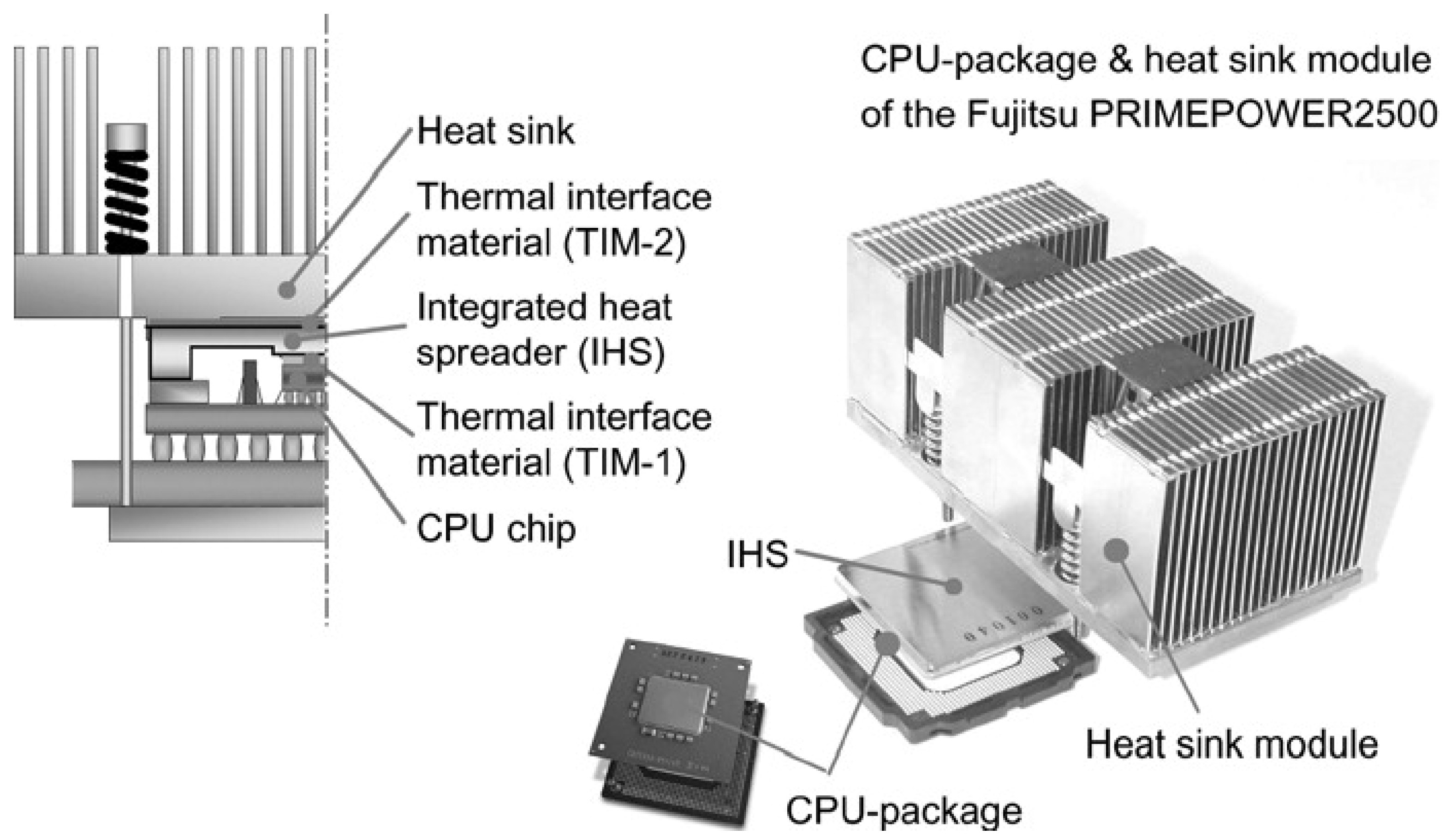
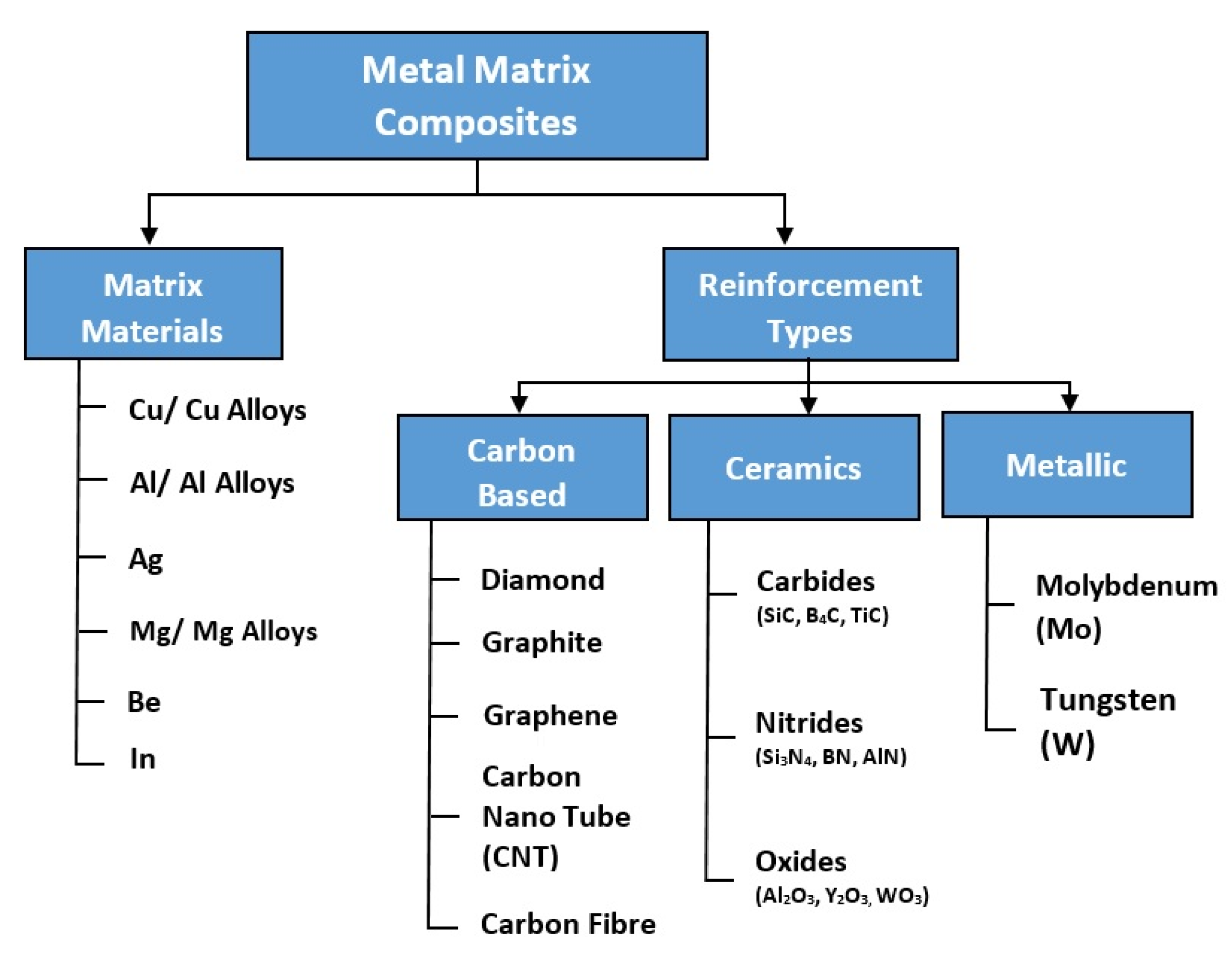

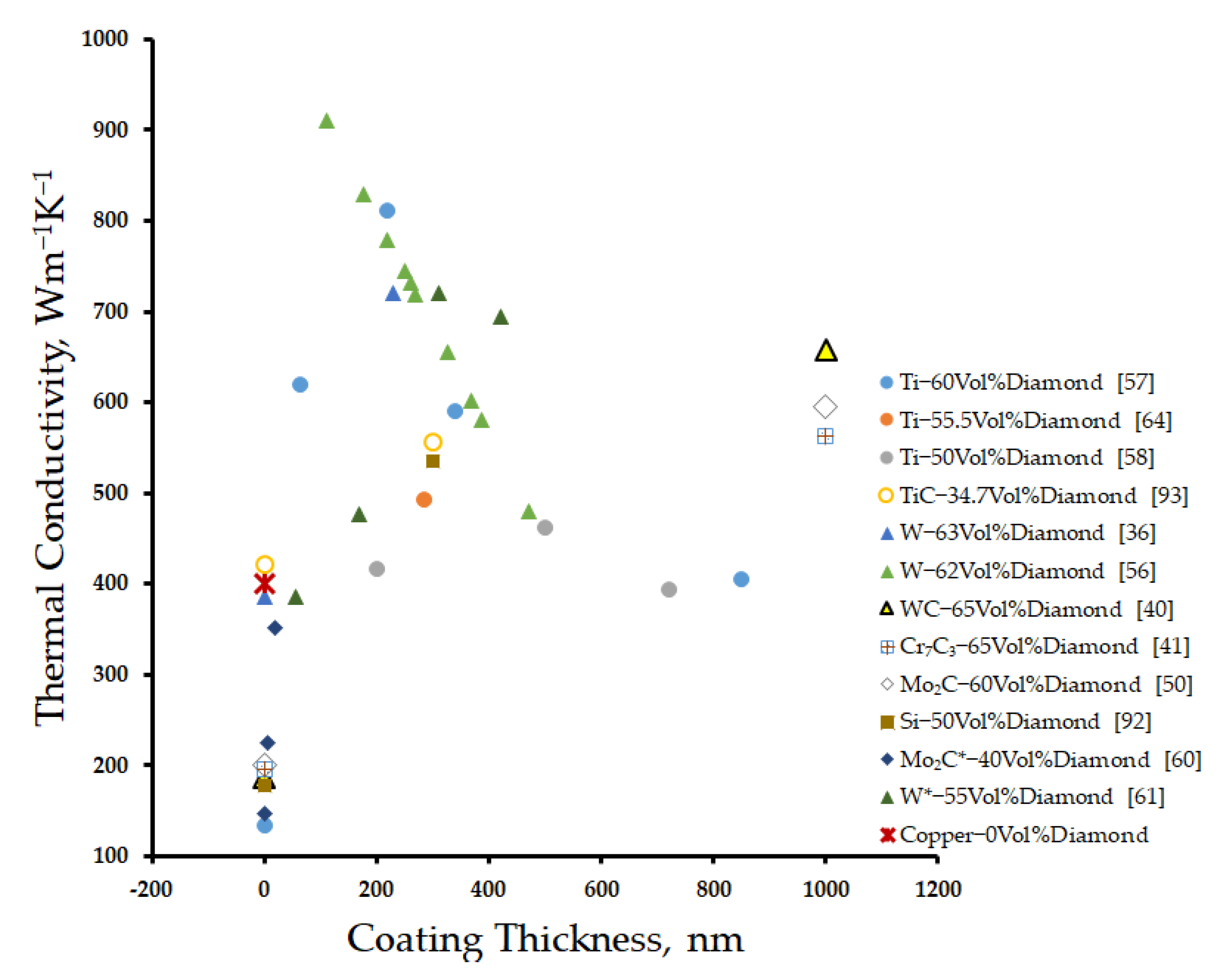
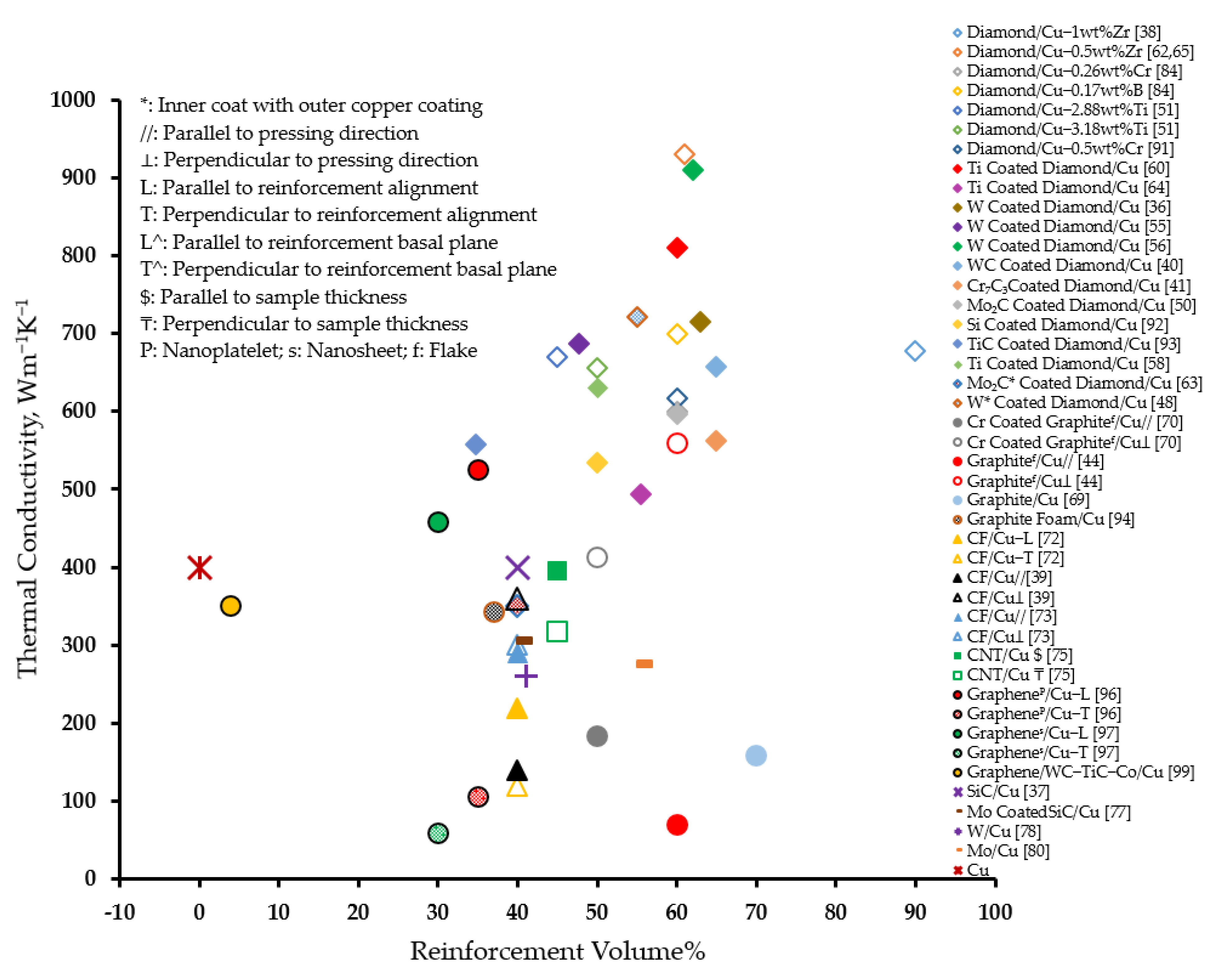
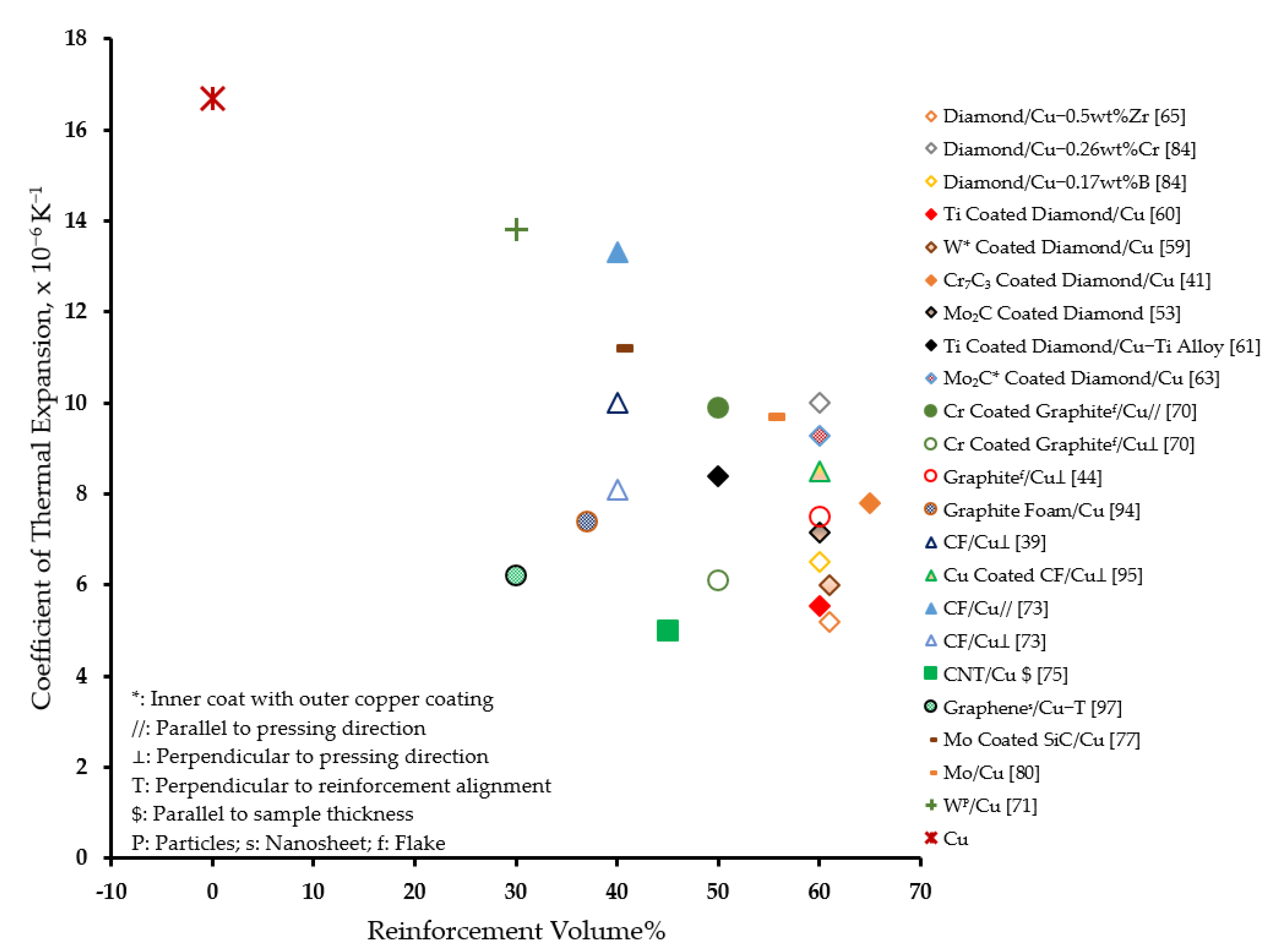
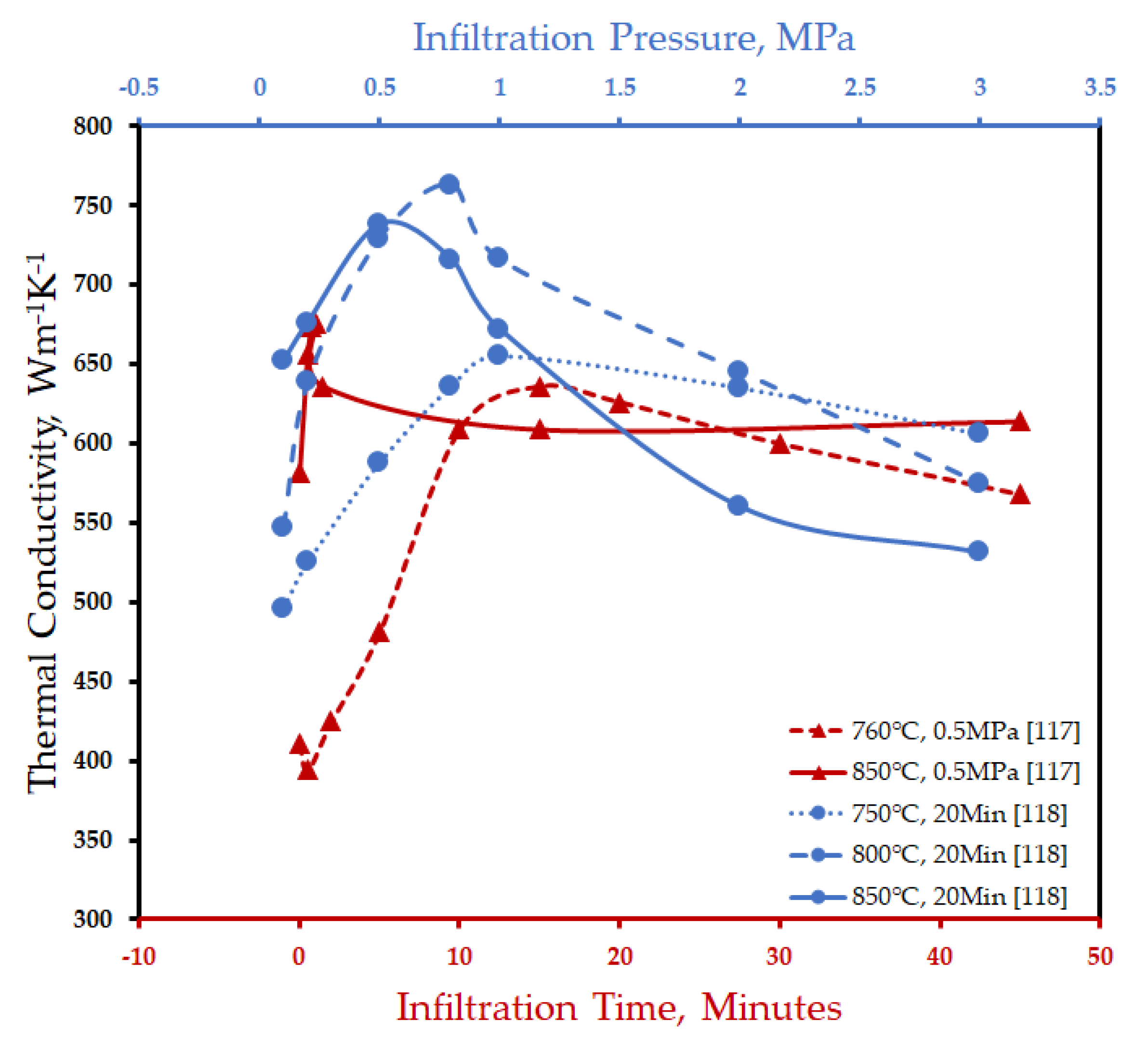
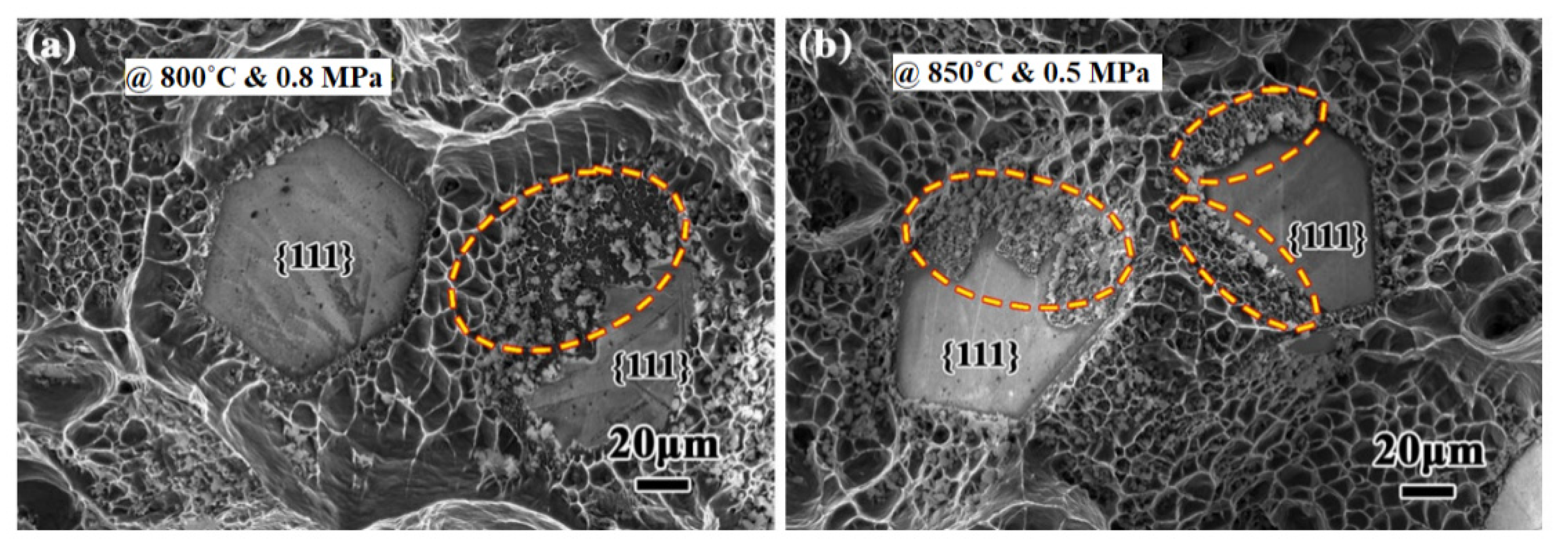
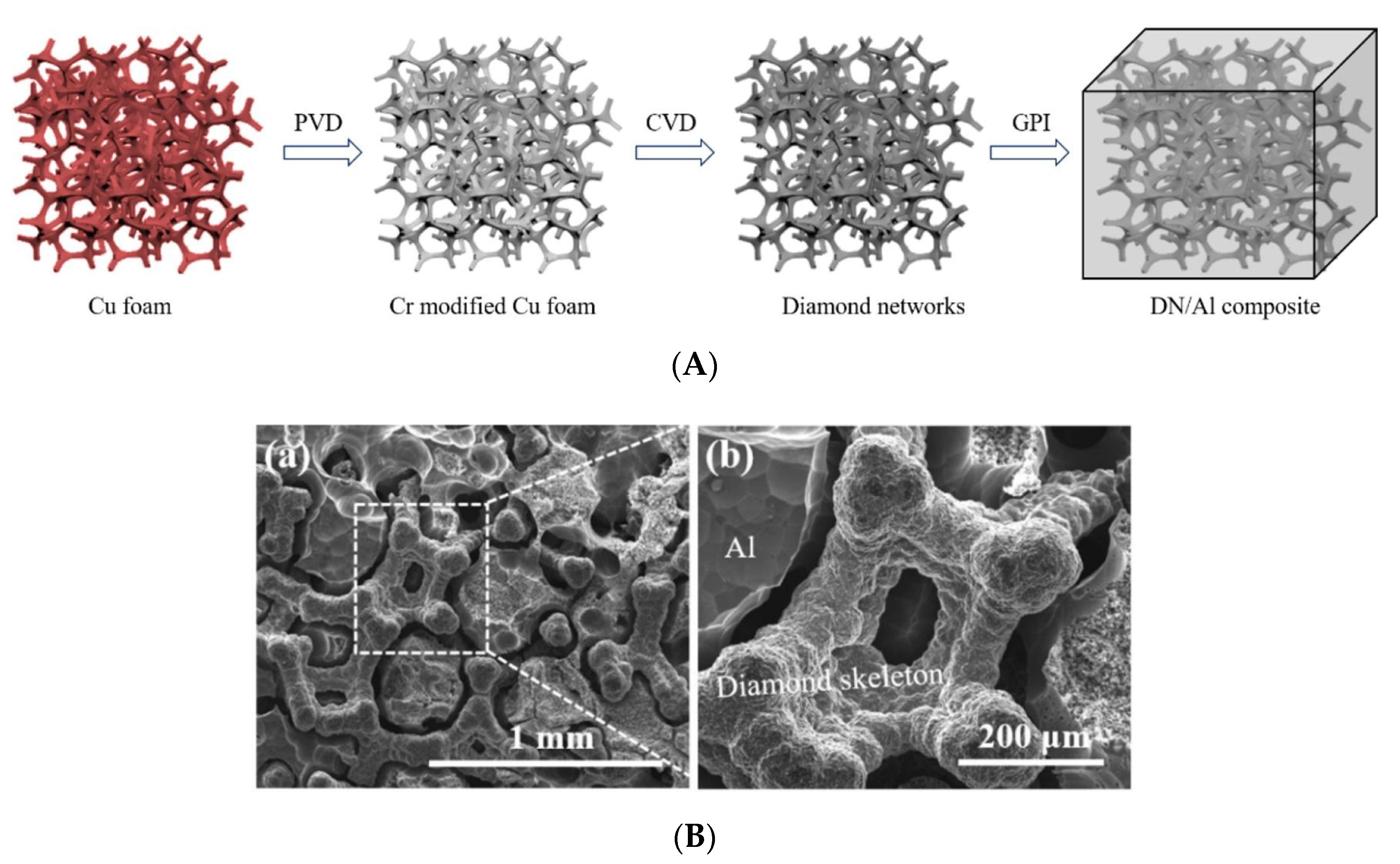
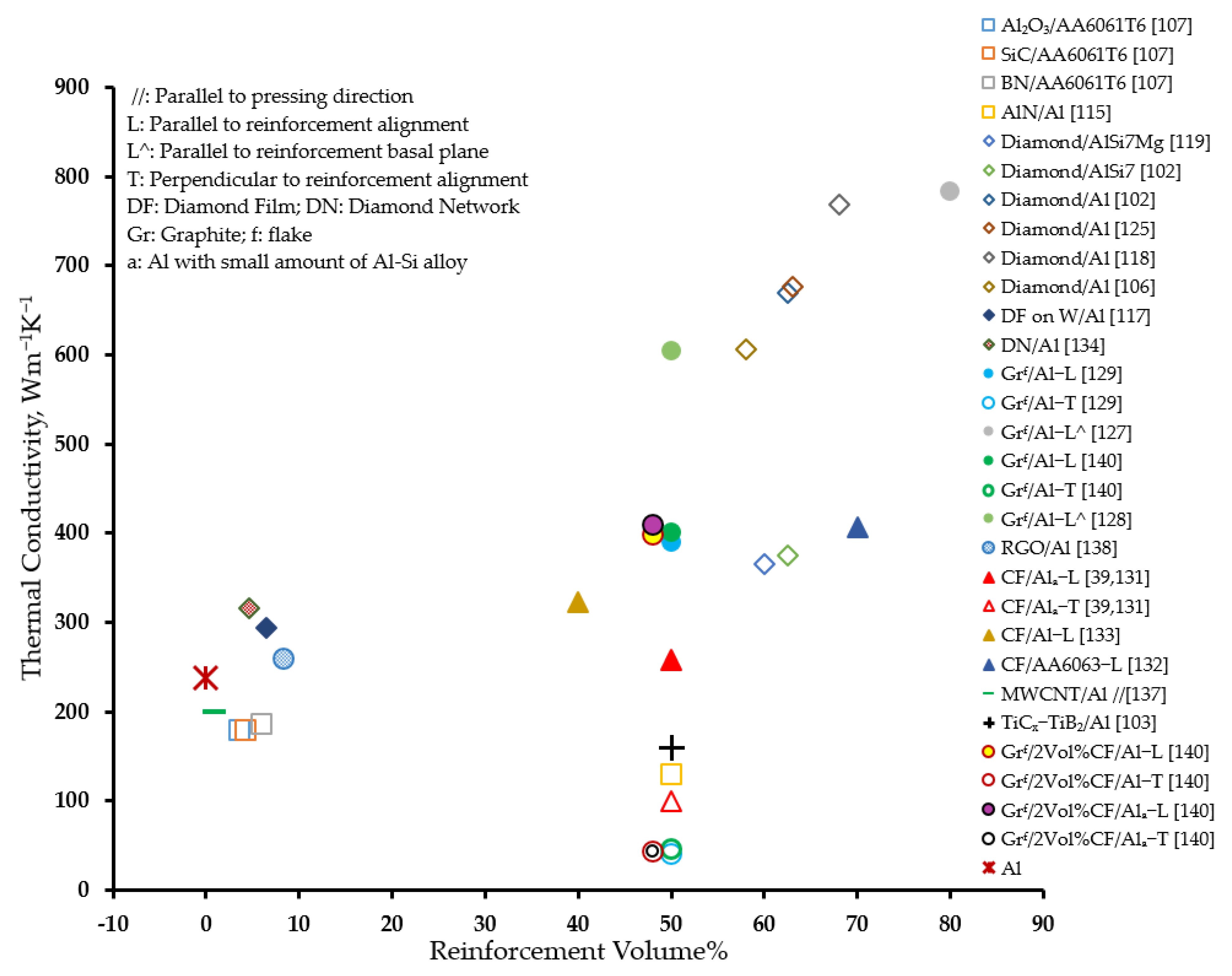
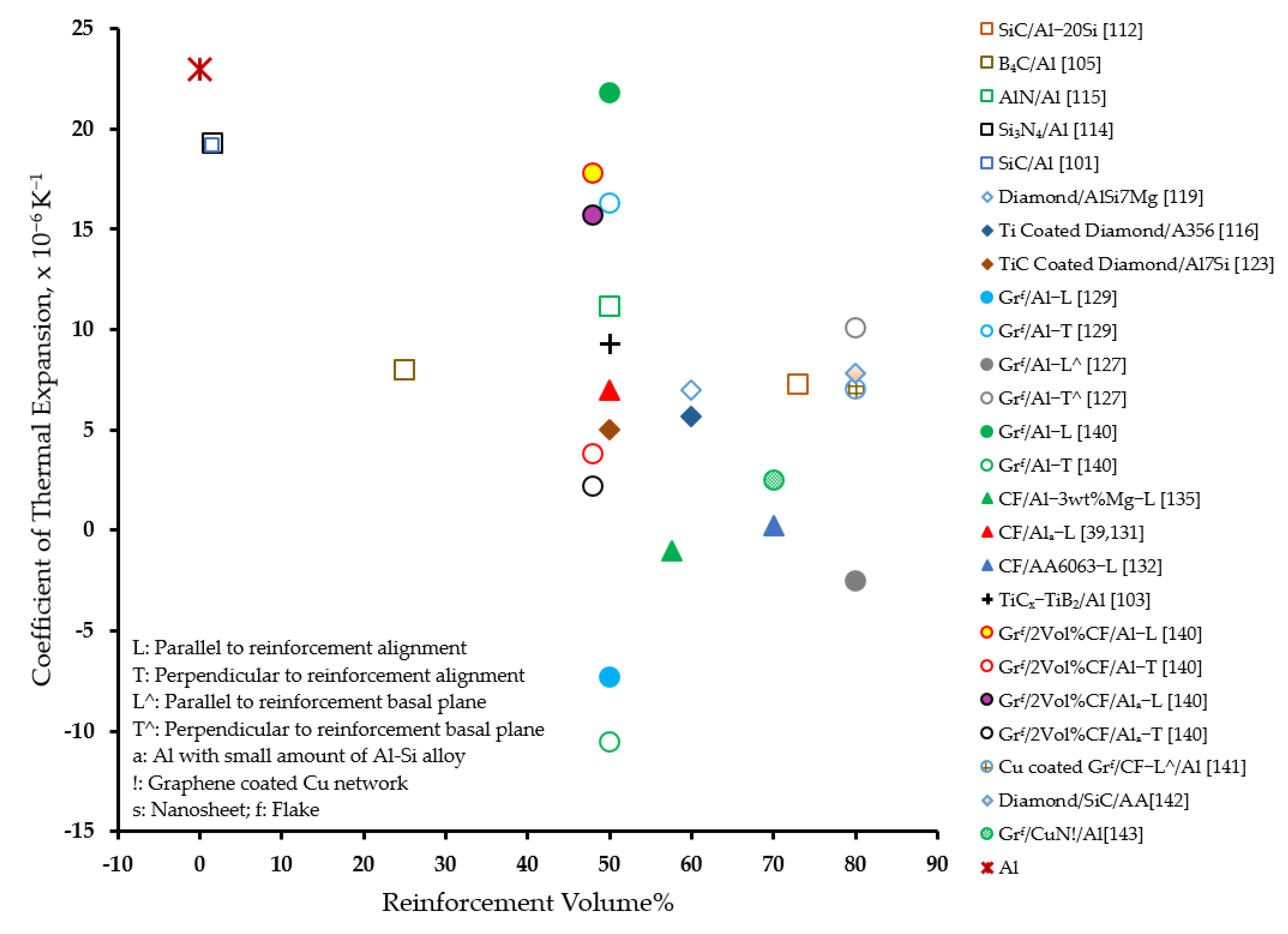
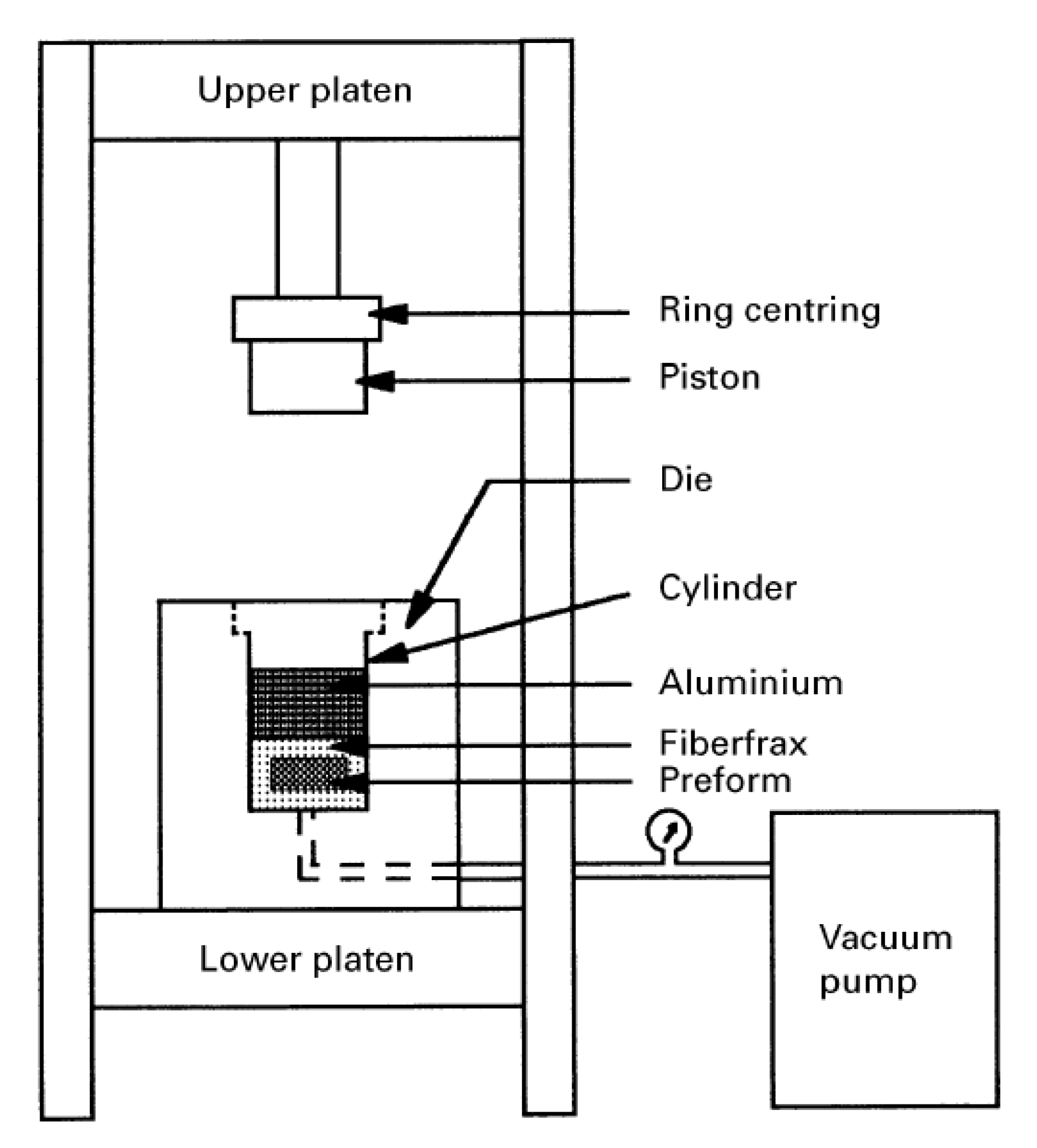
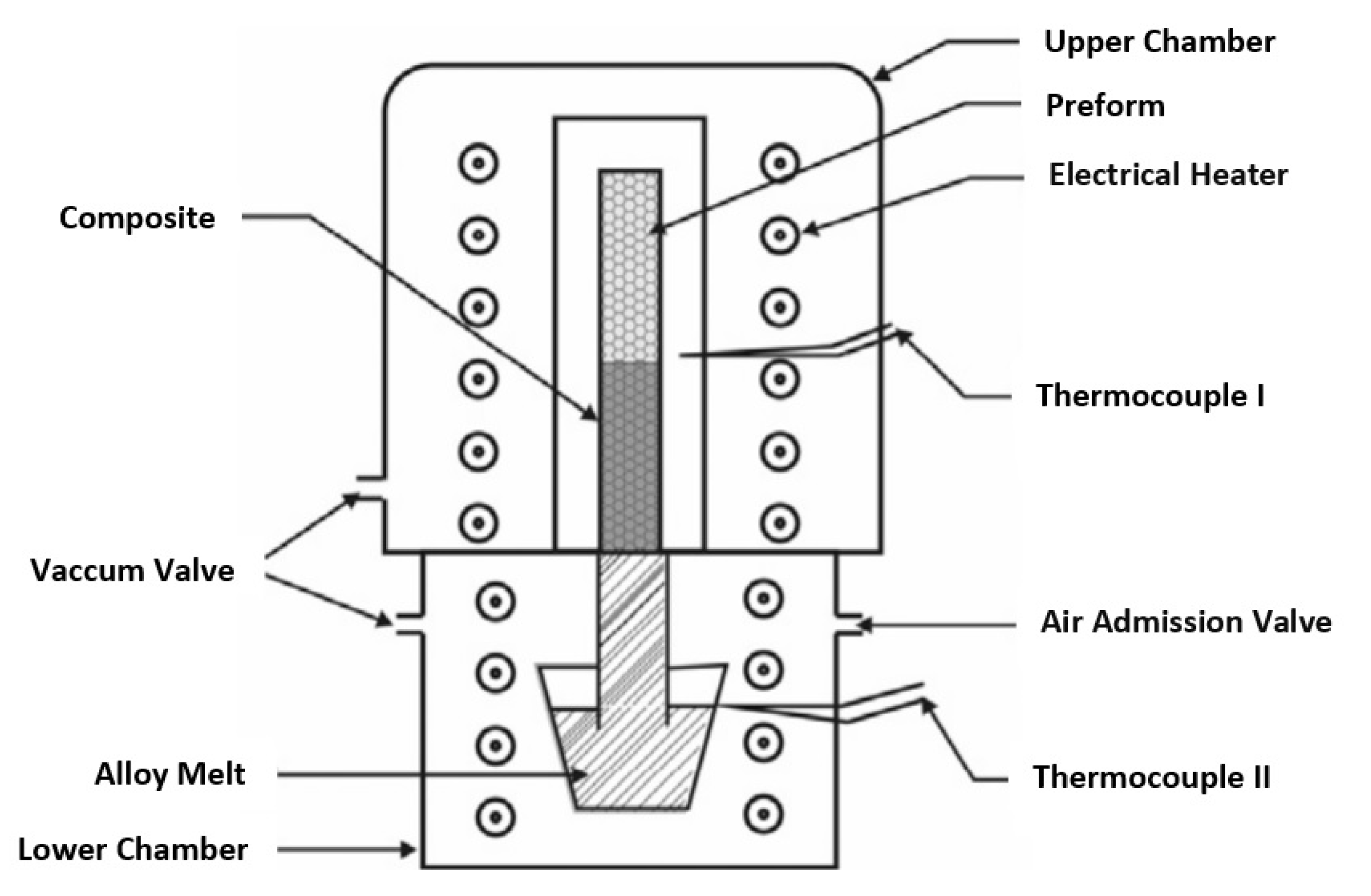
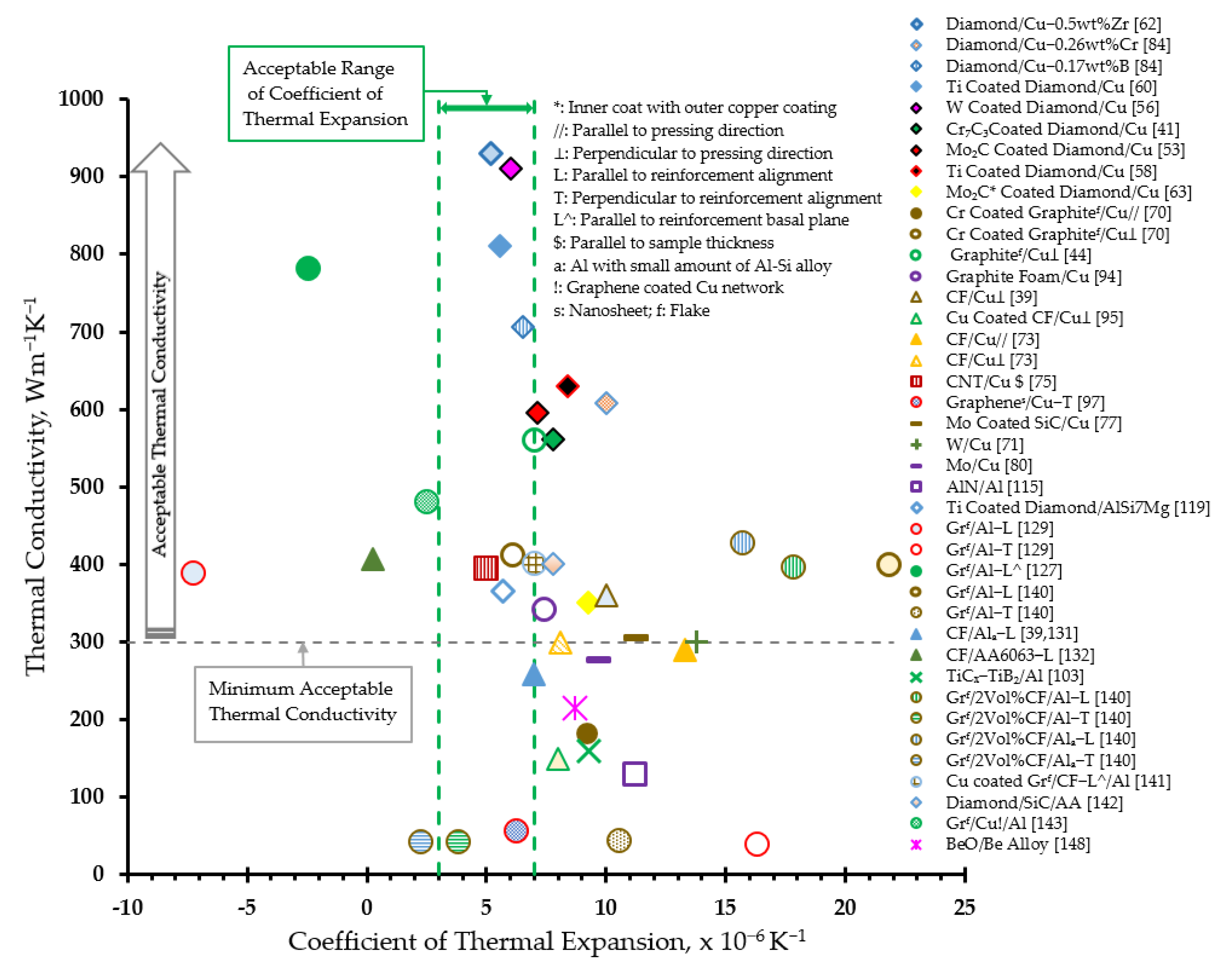
| Matrix | Reinforcement | Composite Fabrication | Thermo-Physical Properties | Ref | ||||||
|---|---|---|---|---|---|---|---|---|---|---|
| Type | Size | Vol% | Pre-Treatment | Process | Parameters | Relative Density (%) | Thermal Conductivity (Wm−1K−1) | CTE (×10−6K−1) | ||
| Cu-1 wt%Zr | Diamond | 220–245 µm | 90 | - | HTHP | 1500 °C under 5 GPa for 5 min | - | 677 | - | [38] |
| Cu-0.5 wt%Zr | Diamond | 212–250 µm | 61 | - | GPI | 1423 K under 1 MPa for 30 min | - | 930 | 5.2 | [65] |
| Cu-0.5 wt%Zr | Diamond | 212–250 µm | - | - | GPI | 1423 K under 1 MPa for 30 min | - | 930 | - | [46] |
| Cu-5 wt% B | Diamond | 177–210 µm | 44 | - | SPS | 1200 K under 30 MPa for 6 min at 150 K/min | - | 660 | - | [62] |
| Cu-0.26 wt%Cr | Diamond | 200 µm | 60 | - | GPI | 1450 K under 0.6 MPa for 30 min | - | 600 | 10 | [84] |
| Cu-0.17 wt%B | - | 700 | 6–7 | |||||||
| Cu-2.88 wt% Ti | Diamond | 30–40 µm | 45 | - | SPS | 920–945 °C under 30–45 MPa for 10 min at 100 °C/min | 97 | 670 | - | [54] |
| Cu | Diamond | 178–200 µm | 80 | Cu-0.5B-coated | SPS | 1000 °C for 5 min | 99.3 | 300 | - | [45] |
| Cu | Diamond | 150–180 µm | 60 | Ti-coated (220 nm) | GPI | 1423 K under 1 MPa for 15 min | - | 811 | 5.55 | [60] |
| Cu | Diamond | 75 µm | 56 | Ti-coated (t:285 nm) | SPS | 1243 K under 40 MPa for 10 min | - | 493 | - | [67] |
| Cu | Diamond | 180 µm | 63 | W-coated (t:220–230 nm) | VPI | 1130–1150 °C under 5 Pa for 5 min | ~80.2 | 715 | - | [36] |
| Cu | Diamond | 180 µm | 61–63 | W-coated (t:110–470 nm) | VPI | 1130–1150 °C under 10 Pa for 5 min | ~77.5–83 | 910–480 | 6 | [59] |
| Cu | Diamond | 200 µm | 50 | W-coated (t:260 nm) | PPS | 900 °C under 80 MPa for 10 min | 97 | 686 | - | [58] |
| Cu | Diamond | 70 µm | 65 | WC-coated (t:1 µm) | VPI | 1150 °C under 20 Pa for 5 min | 99.5 | 658 | - | [40] |
| Cu | Diamond | 70 µm | 65 | Cr7C3-coated (t:1 µm) | VPI | 1150 °C under 20 Pa for 5 min | 97 | 562 | 7.8 | [41] |
| Cu | Diamond | 70 µm | 60 | Mo2C-coated | VPI | 1150 °C under 20 Pa for 5 min | 99.5 | 596 | 7.15 | [53] |
| Cu | Diamond | 300 µm | 50 | Si coated (0.3 µm) | SPS | 867–910 °C for 3 min under 50 MPa | 96.3 | 535 | - | [92] |
| Cu | Diamond | 394 µm | 34.7 | TiC coated (300 nm) | Electrodeposition | Current: DC, 20 mA/cm2; pH:0.9; 150–250 rpm, 50 °C | - | 557 | - | [93] |
| Cu-0.5 wt% Ti | Diamond | 180 µm | 50 | Ti-coated (t:0.5 µm) | SPS | 1000 °C for 10 min under 50 MPa | 99 | 630 | 8.4 | [61] |
| Cu-0.5 wt%Cr | Diamond | 150–180 µm | 60 | - | GPI | 1423 K under 1 MPa for 30 min | - | 617 | - | [91] |
| Cr-Coated | - | 810 | - | |||||||
| Cu | Diamond | 100 µm | 60 | Cu(outer)-W(inner) Coated | Cold Pressing+ Furnace sintering | 1.2 GPa & 1100 °C for 1 h | >99.5 | 661 | - | [48] |
| Cu | Diamond | 400 µm | 55 | Cu(outer)-W(inner) Coated (310 nm) | Powder Metallurgy—HPS | 900 °C under 80 MPa for 30 min | - | 721 | - | [64] |
| Cu | Diamond | 10 µm | 60 | Cu (outer)-Mo2C (inner) Coated | PAS | 850 °C under 20 MPa for 5 min | 99.1 | 351 | 9.27 | [63] |
| Cu | Graphite Fiber | d:10 µm; l:100–200 µm | 50 | Cr-coated | PM +Vacuum HPS | 940 °C under 35 MPa for 40 min in vacuum (0.001 Pa) | 98.04 | 412 ꓕ, 182 // | 6.1 ꓕ, 9.9 // | [70] |
| Cu | Graphite Flakes | d:115 µm; t:10–20 µm | 60 | - | Hot Pressing | - | - | 560 ꓕ, 70 // | 7–8 ꓕ | [44] |
| Cu | Graphite Particles | 30–150 µm | 70 | W-coated | Vacuum HPS | 950 °C under 40 MPa for 30 min | ~62 | 158 | - | [69] |
| Cu | Graphite Foam | Cell size:300 µm | 36.9 | Refractory metal coating | Liquid Metal Infiltration | NA | 75.2 | 342 | 7.4 | [94] |
| Cu | Carbon-Fiber | - | 40 | Cu-coated | Diffusion Bonding | 600 °C under 100 MPa for 15 min in vacuum | - | 220 L, 120 T | - | [72] |
| Cu | Carbon-Fiber | d:9–10 µm; l:100–300 µm | 40 | - | HPS | 650 °C under 50 MPa for 20 min in vacuum (0.66 Pa) | 97 | 360 ꓕ, 140 // | 10 ꓕ | [39] |
| Cu | Carbon-Fiber | - | 60 | Cu-coated | Hot Pressing | - | ~69 | 150 ꓕ, 50 // | 8–9 ꓕ | [95] |
| Cu | Carbon-Fiber | d:10 µm; l:100–300 µm | 40 | - | Hydrothermal Sintering | 265 °C under 250 MPa for 60 min | 100 | 300 ꓕ, 290 // | 8.1 ꓕ, 13.3// | [73] |
| Cu | CNTs | d:3 nm; l:500 µm | 45 | - | Electrodeposition | - | - | 395 $, 317 ₸ | 5 | [75] |
| Cu | GO | - | 1.18 | - | Hot Press Sintering | 900 °C under 25 MPa for 60 min | - | 395 | - | [98] |
| Cu | Graphene Nanosheets | l:5–30 µm t:5–10 nm | 30 | - | Vacuum Filtration + SPS | 760 °C under 50 MPa for 5 min | - | 458 L, 58 T | 6.2 T | [97] |
| Cu | Graphene Nanoplatelets | l:25 µm t:12 nm | 35 | - | Vacuum Filtration + SPS | 750 °C under 50 MPa for 5 min | - | 525 L, 106 T | - | [96] |
| Cu | Graphene Nanosheets | t:2–10 nm | 4 | Cu-coated | Compaction + Furnace Sintering | 900 MPa; 1000 °C, 140 min | 89 | 350 | - | [99] |
| WC-TiC-Co | d:0.5–1 µm | 6.71 | Cu-coated | |||||||
| Cu alloy (C10200) | SiC | 710 µm | 40 | - | Stir Casting | 1090 °C | - | 400 | - | [37] |
| Cu | SiC | 150–210 µm | 40 | Mo Coated | HPS | - | - | 306 | 11.2 | [77] |
| Cu | W wire | - | 20 | - | Pressure Infiltration | - | - | 300 | - | [71] |
| Cu | W particles | - | 30 | - | Pressure Infiltration | - | - | ~300 | 13.3–14.4 | [71] |
| Cu | W particles | - | 60 | - | Pressure Infiltration | Infiltration of the preform at 1150 °C for 2 h | - | 260–240 (RT-800 °C) | - | [78] |
| Cu | Mo | 3.5 µm | 55 | - | Squeeze Casting | Infiltration of Mo preform at 30 MPa at 900–1100 °C for 5 min | - | 276.2 | 9.7 | [80] |
| Al-Si20 Alloy | SiC | 20 µm + 60 µm (4:1) | 73 | - | Squeeze Casting | Infiltration of SiC preform at 100 MPa | - | - | 7.3 | [112] |
| AA356 | SiC | 37 µm | 45 | - | Compaction + Furnace Sintering | 450 MPa; 500 °C, 6 h | - | 235 | - | [110] |
| AA6061T6 | Al2O3 | - | 5 | - | Stir Casting | Stirring:500 rpm for 12 min at 600 °C in Argon atmosphere; Pouring temperature: 900 °C | - | 180 | - | [107] |
| SiC | - | 5 | - | - | 179 | - | ||||
| CBN | - | 5 | - | - | 186 | - | ||||
| Al | B4C | 50 µm | 25 | - | Hot Pressing | 450 °C under 400 MPa for 1 h | - | - | 8 | [105] |
| Al | AlN | 4 µm | 50 | Squeeze Casting | - | - | 130 | 11.2 | [115] | |
| Al | Si3N4 | 15–30 nm | 1.5 | - | Mechanical Alloying +Microwave Sintering | 500 °C | - | - | 19.3 | [114] |
| Al | SiC | 15 nm | 1.5 | - | PM +Microwave Sintering | 550 °C | - | - | 19.2 | [101] |
| Al-Si7 Alloy | Diamond | 91–106 µm | 60 | - | GPI | 750 °C under 8 MPa for 20 min | - | 375 | 7 | [119] |
| A356 | Diamond | 91–106 µm | 60 | Ti coated | GPI | 4 KPa for 20 min | - | 365 | 5.69 | [116] |
| Al-Si7 Alloy | Diamond | 54 µm | 50 | TiC coated | GPI | 700 °C under 1.2 MPa | - | - | 5–8.29 | [123] |
| Al | Diamond | 150–180 µm | - | W coated (45 nm) | GPI | 800 °C under 1 MPa for 60 min | - | 620 | - | [124] |
| AlSi7 Alloy | Diamond | 91–106 µm | 60–65 | - | GPI | 750 °C under 8 MPa for 20 min | - | 375 | - | [102] |
| Al | - | 670 | - | |||||||
| Al | Diamond | 395 µm | 62 | - | GPI | 760 °C under 0.5 MPa for 15 min | - | 636 | - | [125] |
| 850 °C under 0.5 MPa for 1 min | - | 676 | - | |||||||
| Al | Diamond | 150–178 µm | 68 | - | GPI | 750 °C under 1 MPa for 20 min | 99.2 | 655 | - | [126] |
| 800 °C under 0.8 MPa for 20 min | 99.28 | 760 | - | |||||||
| 850 °C under 0.5 MPa for 20 min | 99.35 | 738 | - | |||||||
| Al | Diamond | 90–106 µm | 58 | Squeeze Casting | 800 °C under 15 MPa for 15 min | - | 321 | - | [106] | |
| - | Squeeze Casting (Optimized) | 850 °C under 15 MPa for 90 min | - | 606 | - | |||||
| Al | Diamond | 10–15 µm | 4.6 | - | GPI | 800 °C under 5 MPa for 10 min | - | 315.7 | - | [134] |
| Al2024 | Graphite flakes | d:500 µm; t:10 µm | 50 | - | SPS | 600 °C for 10 min under 45 and 50 MPa | - | 390 L; 40 T | −7.3 L; 16.3 T | [129] |
| Al | Graphite flakes | d:550 µm; t:10–30 µm | 80 | - | Vacuum Hot Pressing | 913 K and 60 MPa for 1 h under 2.7 Pa vacuum | - | 783 L^ | −2.5 L^, 10.1 T^ | [127] |
| Al | Graphite flakes | l:550 µm; t:30 µm | 50 | - | HPS | 600 °C under 60 MPa for 30 min | 97.5 | 400 L, 45 T | 21.8 L, −10.5 T | [140] |
| Al | Graphite flakes | l:500 µm | 50 | - | Powder Metallurgy | - | 99.6 | 604 L^ | - | [128] |
| Al | RGO | - | 3 | - | Compaction + Sintering | 200 MPa and 600 °C for 5 h in Argon | 42 | 260 | - | [138] |
| Al-3 wt%Mg | Carbon-Fiber | d:10 µm | 57.6 | - | GPI | 750 °C under 5 MPa for 2 min | - | 540 L | −1 to −1.9 L | [135] |
| Al | Carbon-Fiber | d:11 µm | - | - | Pressure Infiltration | 1073 K under 0.8 MPa for 1 min; cooling-10 min | - | 273.2 L | - | [136] |
| Al+ (5 Vol%) Al-Si alloy | Carbon-Fiber | d:8 µm; l:200 µm | 50 | - | HPS | 600 °C under 60 MPa for 30 min | - | 258 L | 7.09 L | [39] |
| Al+ (5 Vol%) Al-Si alloy | Carbon-Fiber | d:8 µm; l:200 µm | 50 | - | Hot Pressing | 600 °C under 60 MPa for 30 min | 97 | 258 L | 7 L | [131] |
| Al+ (10 Vol%) Al-Si alloy | Carbon-Fiber | d:10 µm; l:270 µm | 40 | - | SPS | 873 K under 10 MPa for 60 min at 20 K/min | 99.4 | 323 L | - | [133] |
| AA6063 | Carbon-Fiber | d:10 µm; l:270 µm | 67.9–70 | - | Pressure Infiltration | 900 °C under 5 MPa for 10 min | - | 407 L | (−0.26 to +0.26) L | [132] |
| Al | MWCNTs | d:20–30 nm; l:10–30 µm | 0.8 | - | SPS | 853 K under 40 MPa for 10 min at 50 K/min | - | 199 // | - | [137] |
| Al | TiCx:TiB2 | - | 50 | - | Hot Pressing | - | - | 160 | 9.3 | [103] |
| Al-12Si Alloy | Graphite flakes | d:400 µm; t:50 µm | 69 | - | GPI | 700 °C under 2.5 MPa for 2 min | - | 390 L | - | [139] |
| SiCp | 22.5 µm | 16 | - | |||||||
| Al | Graphite flakes | l:550 µm; t:30 µm | 48 | - | HPS | 600 °C under 60 MPa for 30 min | - | 398 L,44 T | 17.8 L, 3.8 T | [140] |
| Carbon-Fiber | d:10 µm; l:250 µm | 2 | ||||||||
| Al + (10 Vol%) Al-12Si Alloy | Graphite flakes | l:550 µm; t:30 µm | 48 | 97.9 | 429 L, 44 T | 15.7 L, 2.2 T | [140] | |||
| Carbon-Fiber | d:10 µm; l:250 µm | 2 | ||||||||
| Al | Graphite flakes | d:500 µm | 80 | Cu coated | Vacuum GPI | 750 °C under 2 MPa for 5 min | 95.6 | 402 L^ | 7 L^ | [141] |
| Carbon Fibers | d:14–16 µm; l:80–100 µm | - | N doped | |||||||
| Al-7Si-0.3Mg Alloy | Diamond | d:350 µm | 80 | Ti coated (2 µm) | GPI | 750 °C for 1 min | - | 400 | 7.8 | [142] |
| SiCp | d:45 µm | - | ||||||||
| Al | Graphite Flakes | 270 µm | 70 | - | Hot Pressing | 660 °C under 2.5 MPa for 30 min | - | 482.14 | 2.5 | [143] |
| 3D Cu network | - | - | Graphene coated (5 Vol%) | |||||||
| Ag-11at%Si Alloy | Diamond | 200 µm | 60 | - | - | - | 782 | - | [144] | |
| Ag | CNT | d:8 nm; l:20 µm | 6 | Non-Covalently Functionalized | Compaction and Furnace Sintering | 320 MPa; 800 °C | 91.76 | 530 | - | [145] |
| Mg | Diamond | 400 µm + 58 µm (70:30-Bimodal) | 76 | TiC coated | GPI | 740 °C under 1.5 MPa for 2 min | - | 716 | - | [146] |
| E-20Be Alloy | BeO | - | 20–60 | - | - | - | 215 | 8.7 | [148] | |
Publisher’s Note: MDPI stays neutral with regard to jurisdictional claims in published maps and institutional affiliations. |
© 2021 by the authors. Licensee MDPI, Basel, Switzerland. This article is an open access article distributed under the terms and conditions of the Creative Commons Attribution (CC BY) license (https://creativecommons.org/licenses/by/4.0/).
Share and Cite
Baig, M.M.A.; Hassan, S.F.; Saheb, N.; Patel, F. Metal Matrix Composite in Heat Sink Application: Reinforcement, Processing, and Properties. Materials 2021, 14, 6257. https://doi.org/10.3390/ma14216257
Baig MMA, Hassan SF, Saheb N, Patel F. Metal Matrix Composite in Heat Sink Application: Reinforcement, Processing, and Properties. Materials. 2021; 14(21):6257. https://doi.org/10.3390/ma14216257
Chicago/Turabian StyleBaig, Mirza Murtuza Ali, Syed Fida Hassan, Nouari Saheb, and Faheemuddin Patel. 2021. "Metal Matrix Composite in Heat Sink Application: Reinforcement, Processing, and Properties" Materials 14, no. 21: 6257. https://doi.org/10.3390/ma14216257






